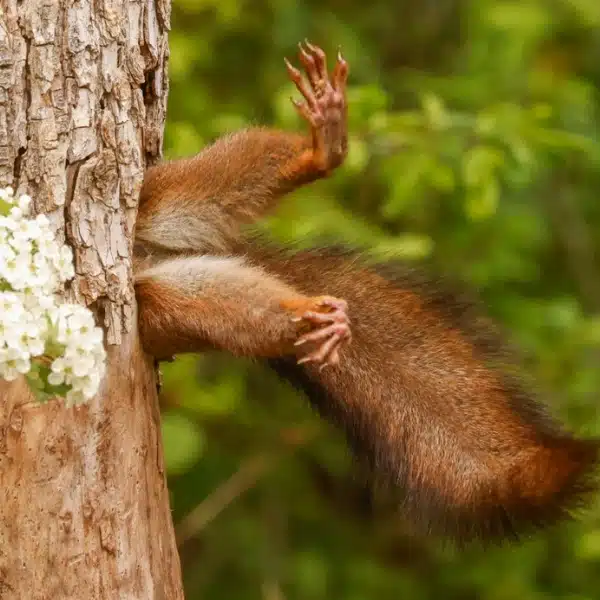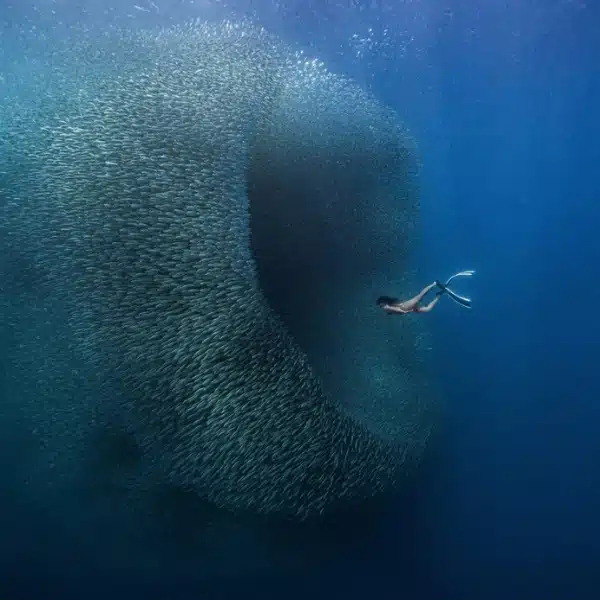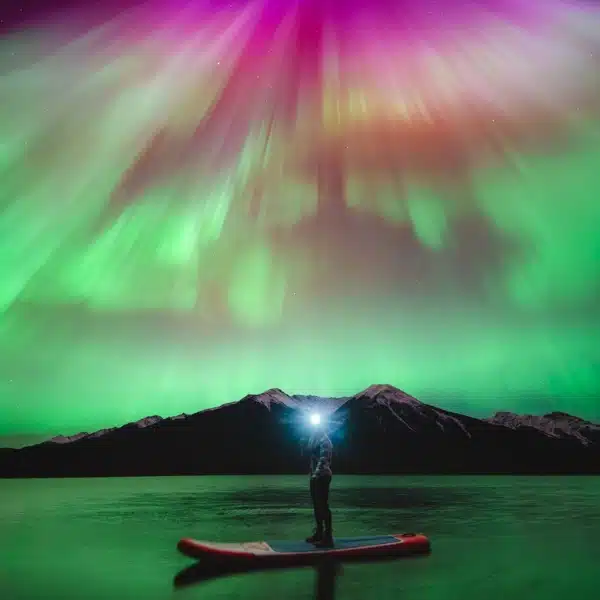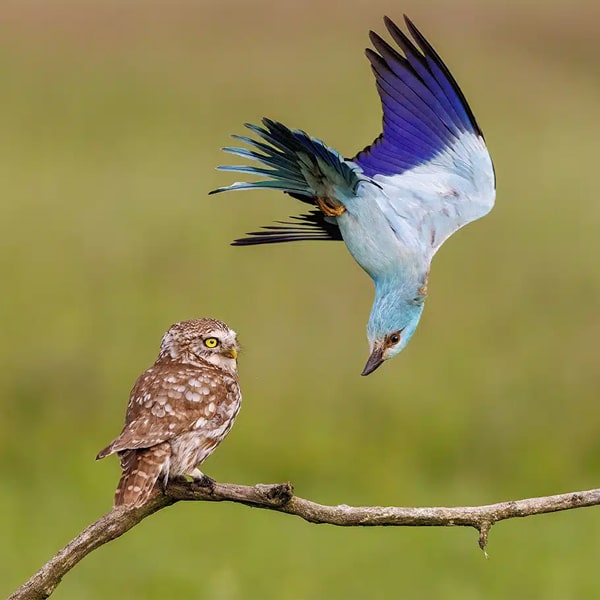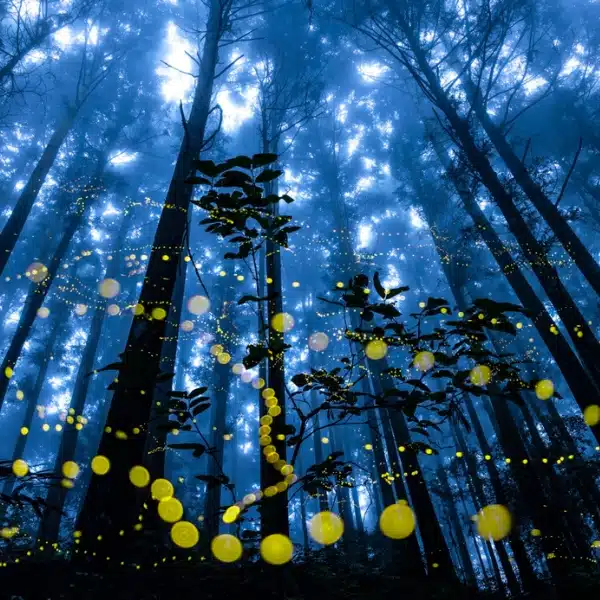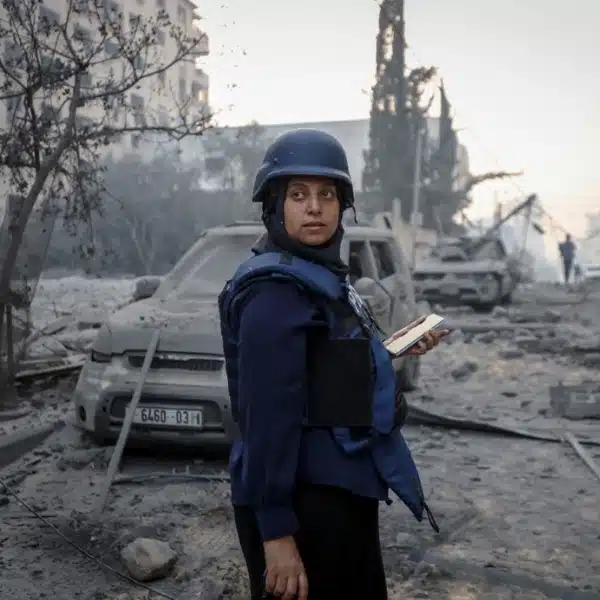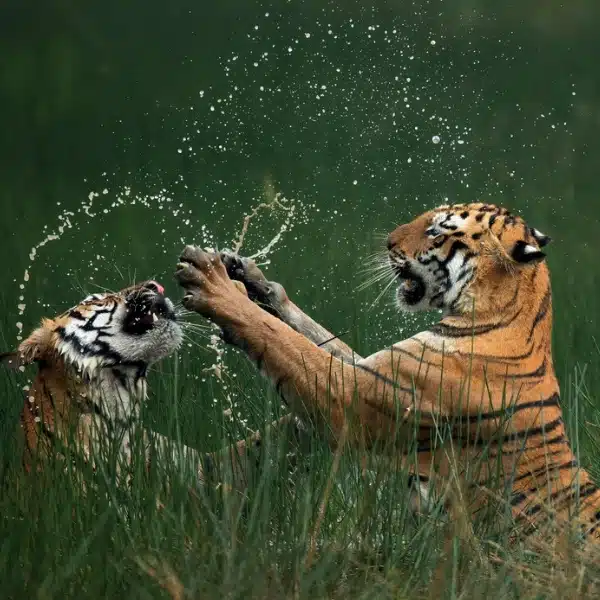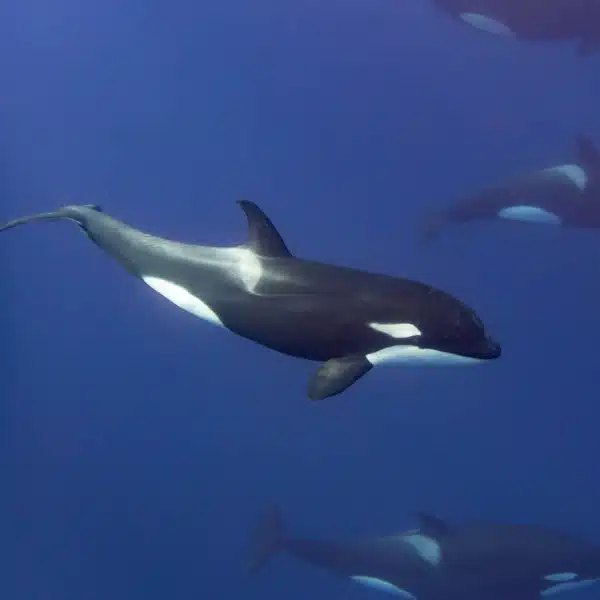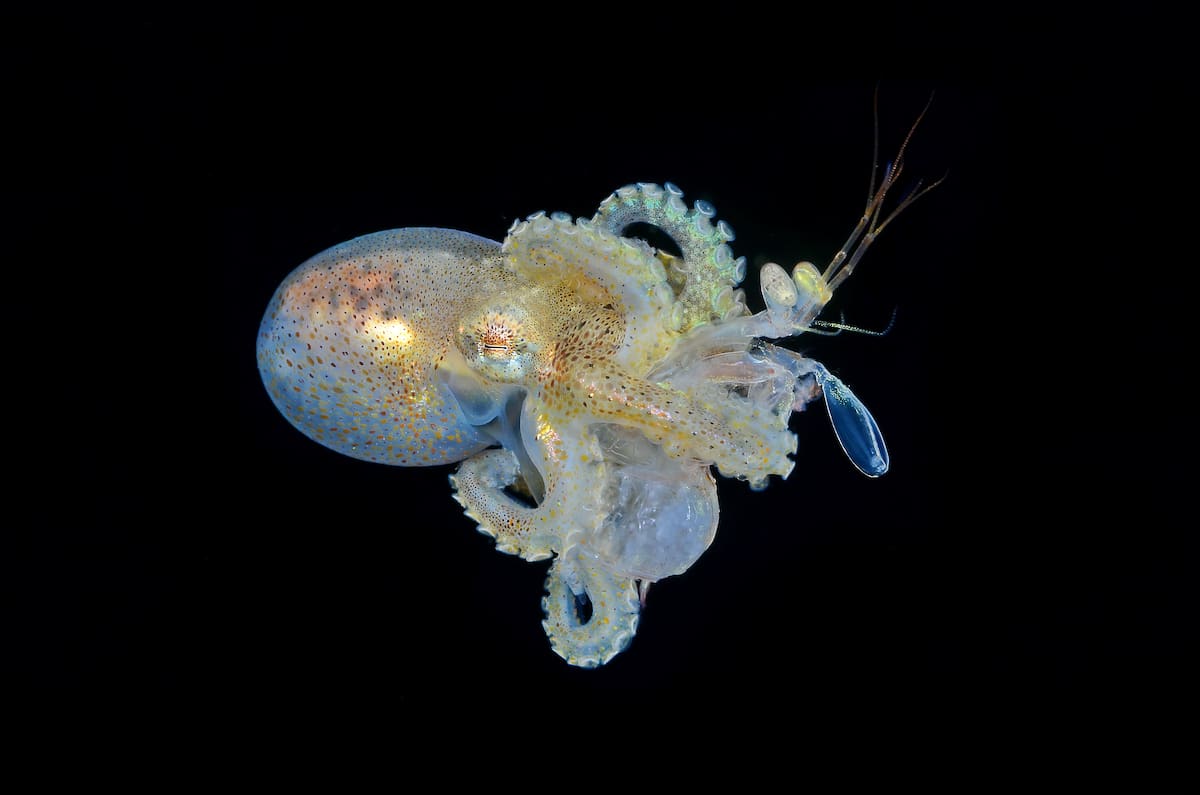
“Octopus Attack” by Dennis Corpuz. Winner, Blackwater
Shot in Anilao, Philippines
“A hungry paralarvae octopus ambushes a larval mantis shrimp. At night during this blackwater dive, we traveled a few kilometers away from the mainland of Anilao. We set up a buoy with a dropline attached with high-powered lumens light at 5, 10, 15, and 20 meters in approximately 200 to 1000 meters deep of water. We regularly observe the vertical migration of all deep-sea living creatures and try to photograph their behavior.”
The prestigious Ocean Art Underwater Photo Competition has announced the results of the world’s largest underwater photo contest. Organized by the Underwater Photography Guide, the photo contest is an incredible survey of life below the surface. And as 2022, with travel restrictions lifted in most parts of the world, these photographers took advantage to capture global marine life.
Kat Zhou took home the top prize for Octopus Mother, an image that demonstrates a new meaning of maternity. In the photo, we see an octopus mother with her tentacles coiled around her eggs. The hatching of her eggs means the end of this mother's life, as octopi don't eat while tending to their eggs and die shortly after birth. For her bittersweet look at this moment, Zhou won a dive trip in the Maldives for two people.
Her triumph is all the more impressive given that winners across all 14 categories are exceptionally strong. From a dramatic blackwater photo of an octopus attack to a perfect portrait of a crab, these special moments are a testament to the tenacity of these underwater photographers. Even more photographers were included in the 2022 competition, as a new Mobile Phone category was added. Photographer Alessandro Buzzichelli won with his image of a Cassiopea jellyfish brightly lit by a stream of light. The quality of his photograph highlights just how much mobile phones have impacted the photography world.
Nirupam Nigam, Editor-in-Chief of the Underwater Photography Guide, was pleasantly surprised by the entries to the contest. “I expected an ‘Instagramable’ moment to steal the show. Instead, each image is that of photographic excellence or poetic reflection of the natural world around us. These images will be seared in my mind for years to come.”
See more of the winners and runners-up for each category below and see the full gallery of winners and finalists online.
The winners of the 2022 Ocean Art Underwater Photo Competition show the beauty of life down below.
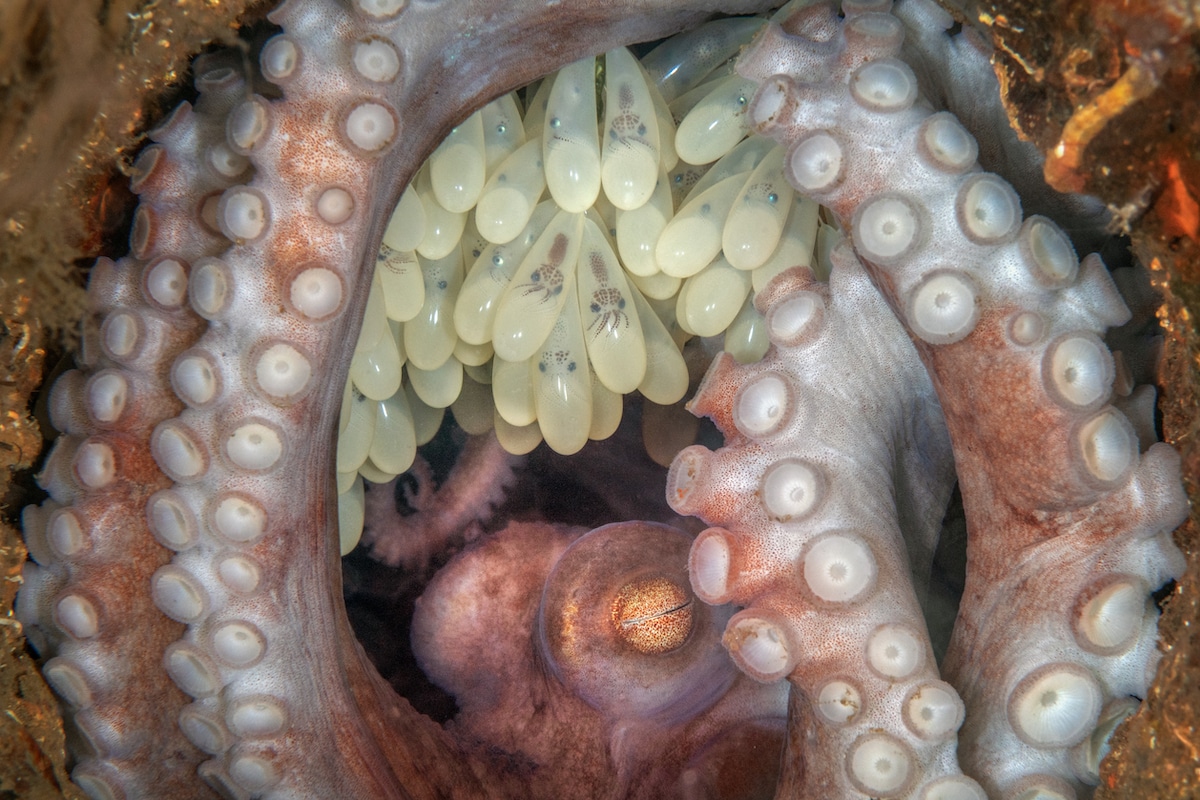
“Octopus Mother” by Kat Zhou. Best in Show and Winner, Macro.
Shot in West Palm Beach, Florida, USA
“This photo shows a Caribbean reef octopus guarding her eggs, found off the coast of West Palm Beach, Florida. Like all other species of octopus, this mother does not eat while she tends to her eggs, and she will die after they hatch. It was a bittersweet feeling to watch her protect her eggs, knowing that this sad end was coming!”
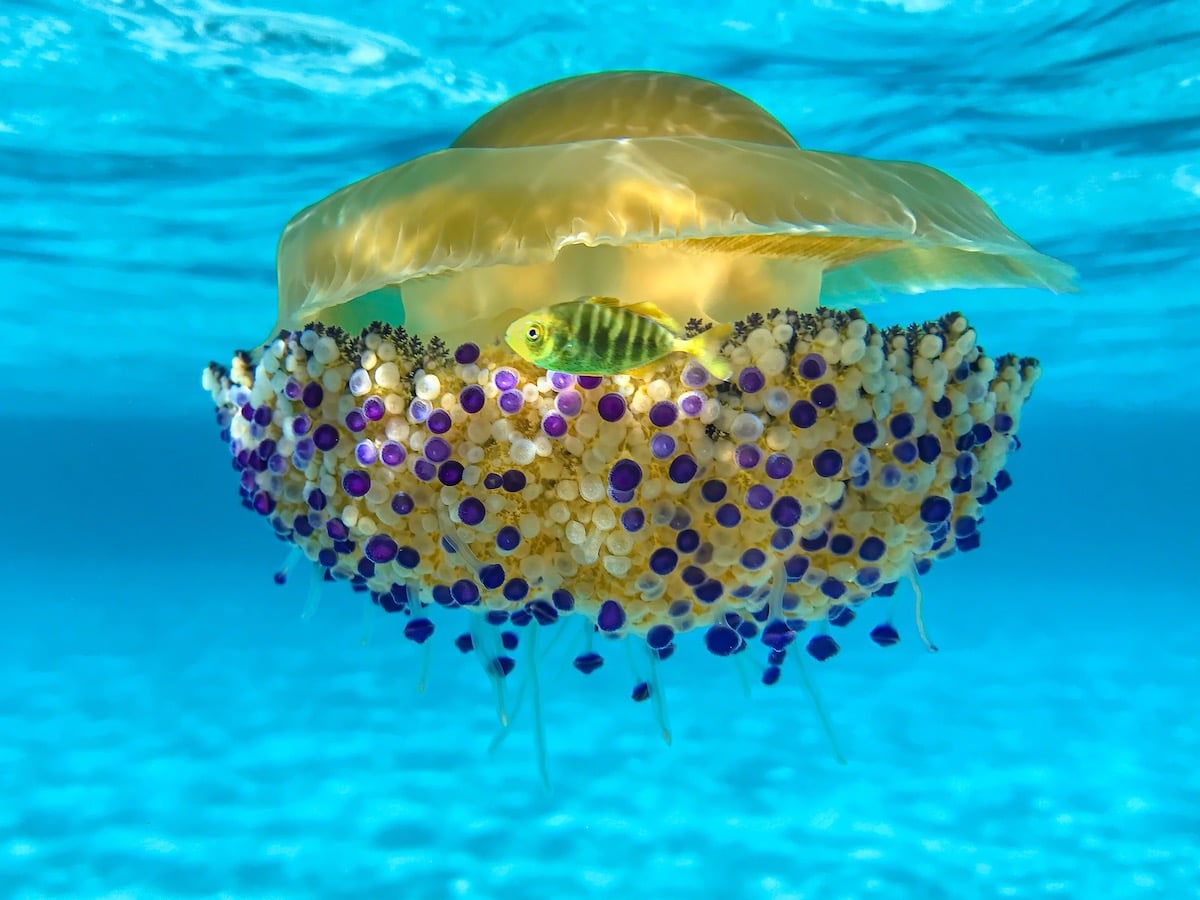
“Cassiopea in the Blue” by Alessandro Buzzichelli. Winner, Mobile Phone
Shot in Cala Liberotto, Italy
“One day Hundreds of Cassiopea jellyfish appeared. The water was very transparent and the sunlight illuminated the scene.”
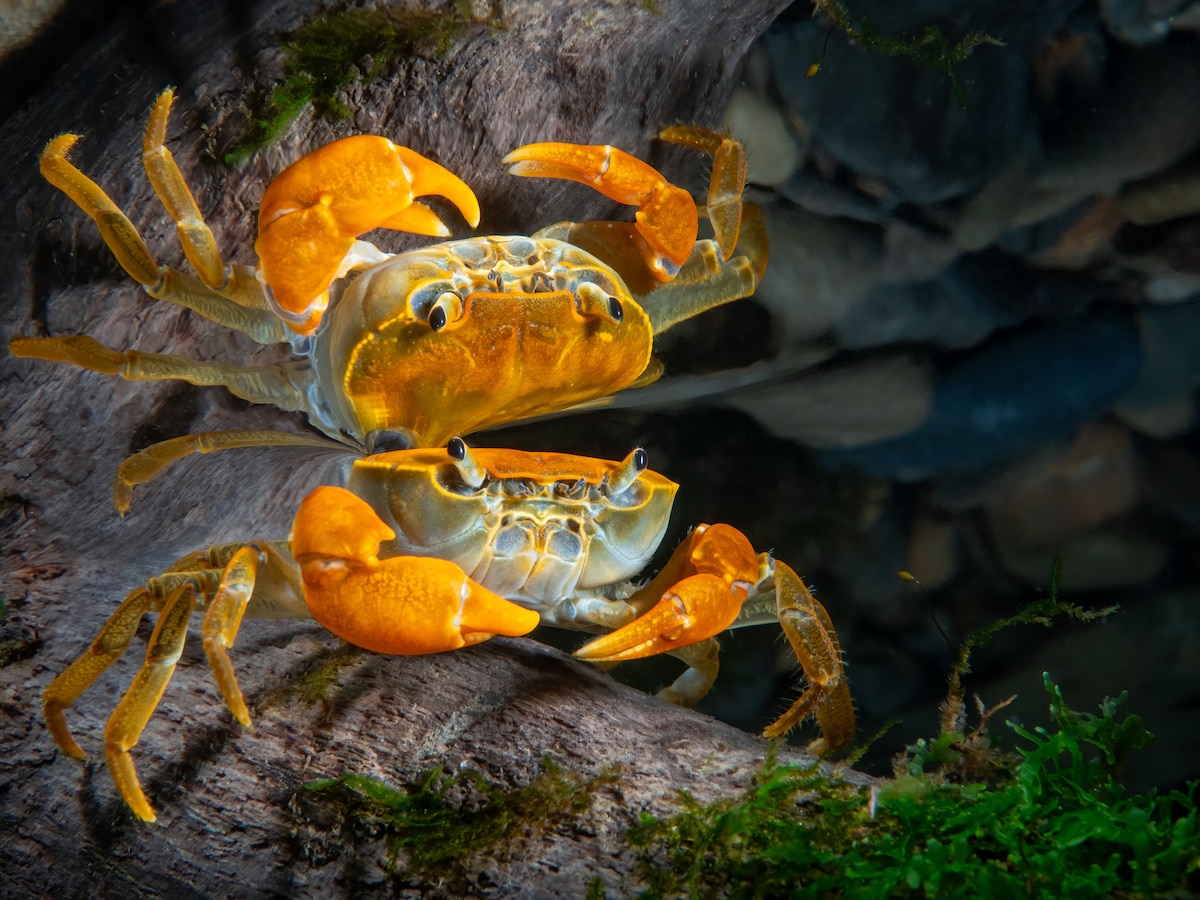
“Mirror Reflection” by Kuo-Wei Kao. Winner, Portrait.
Shot in Pinglin, Taiwan
“Since the pandemic, I was depressed because I couldn’t go diving abroad. On the chance of going out, I went to the stream and found beautiful little crabs. So, I took my photography equipment and went to different spots every week to observe and try to shoot the ecology of the stream. After multiple attempts in the span of several months, I was able to capture the perfect reflection which was one of my goals. When I shot this photo, I knew I got it!”
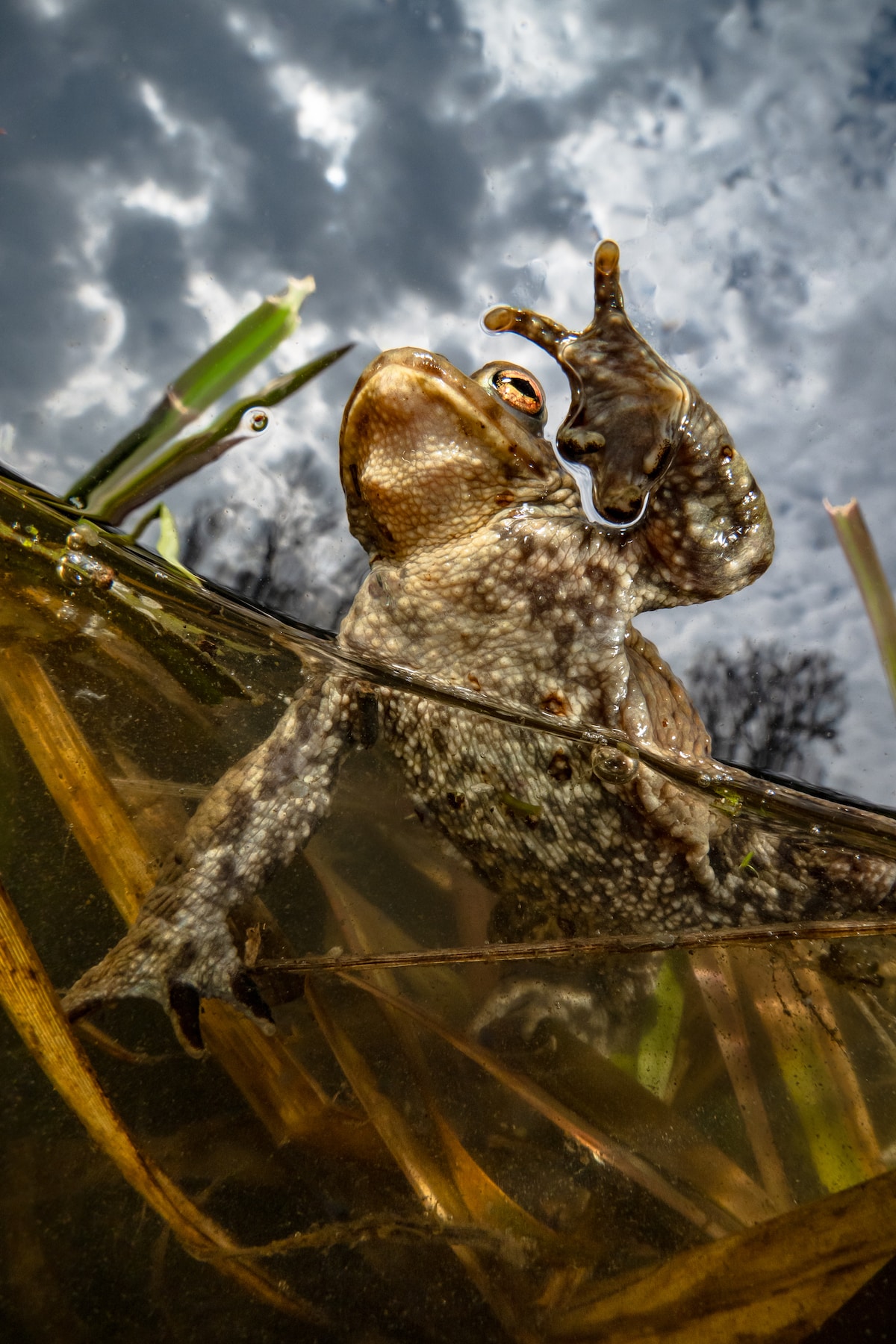
“Peace” by Enrico Somogyi. Winner, Compact Wide Angle
Shot in Leipzig, Germany
“Once a year at the end of March, it is mating time for the toads. It lasts only few days and only at this time is it possible to get very close to them. Normally they are very shy. I was trying to get a split shot with this toad, when he started to crawl on my small dome port. I got some pics from this action and this one was my favorite pic.”
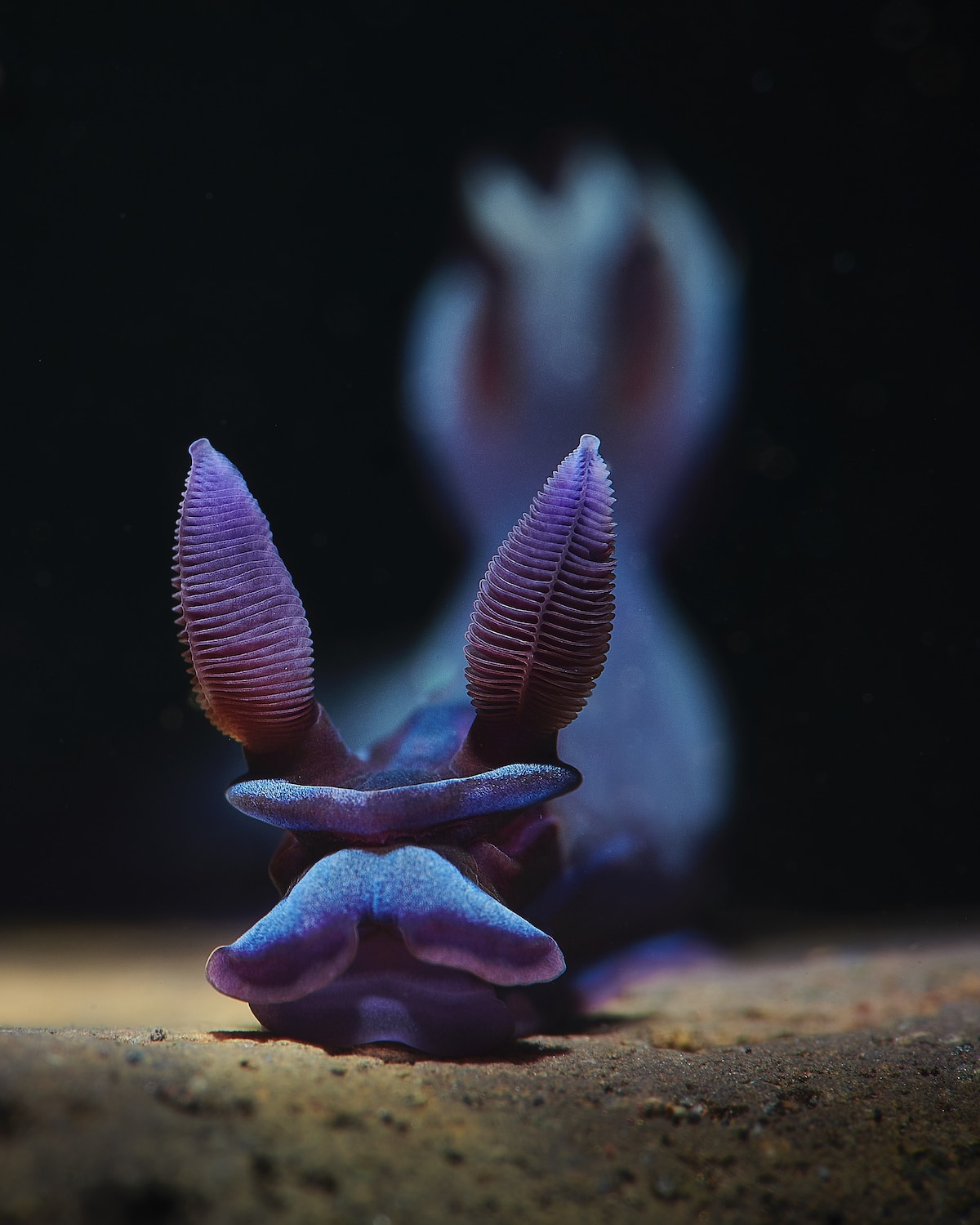
“Ribbed” by Aleksei Permiakov. Winner, Nudibranches
Shot in Tulamben, Bali, Indonesia
“During the pandemic me and my wife got stuck in Bali and that was a great opportunity for macro photography. We explored Tulamben and made a series of dives at the Drop Off dive site where we spotted quite a lot of different subjects. Tambja morosa is a relatively big nudi and usually I would shoot it without a wet lens, but I decided to focus more on rhinophores and its amazing texture.”
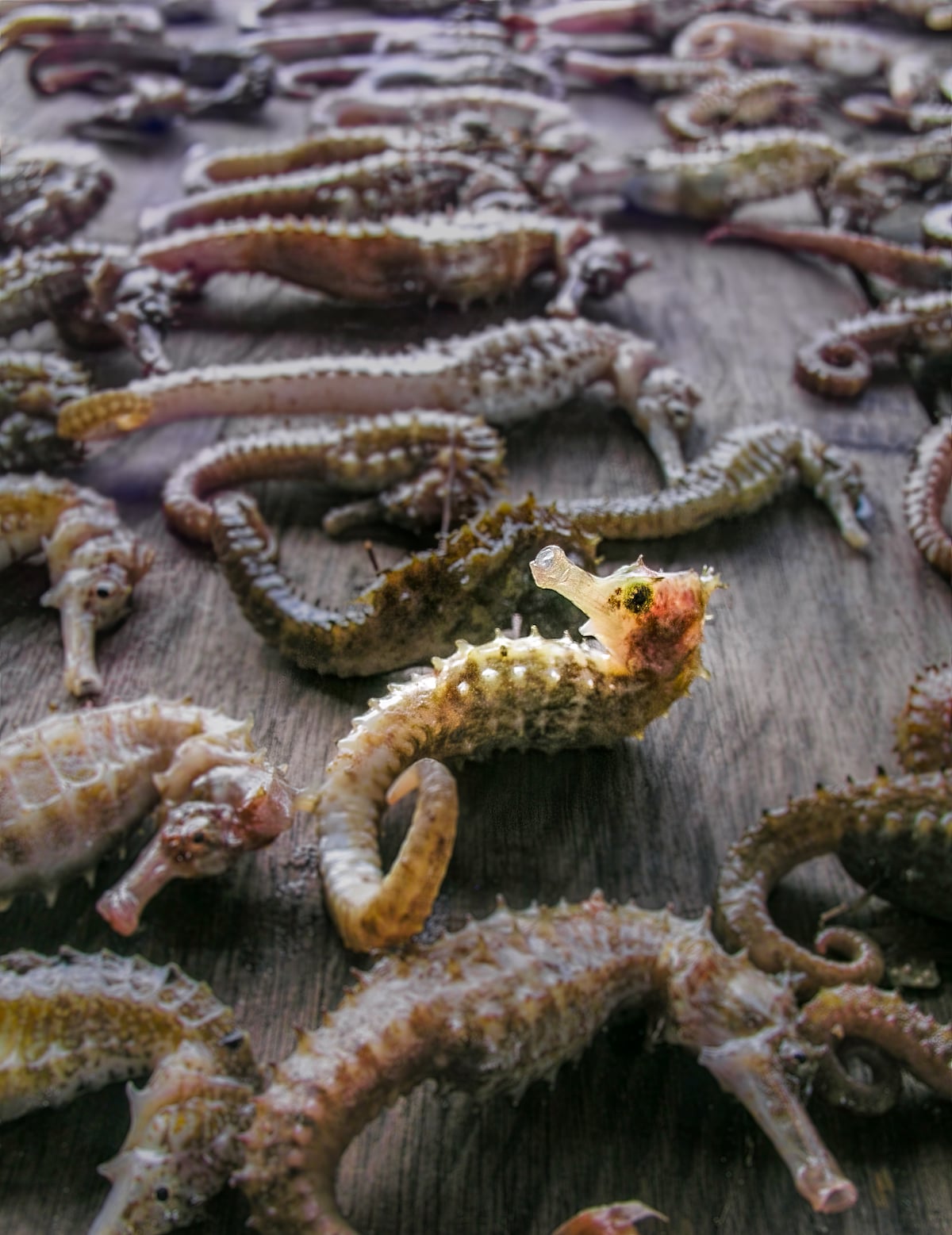
“A Sad Catch” by Lawrence Alex Wu. Winner, Underwater Conservation
“Big or small, our ecosystem is a fine balance and all its inhabitants are important to the well being of the Earth.
Seahorses have been fished to near extinction, mainly for medicinal use… but not scientifically proven to have any medicinal properties.”
With travel restrictions lifted, these underwater photographers were able to explore different parts of the world.
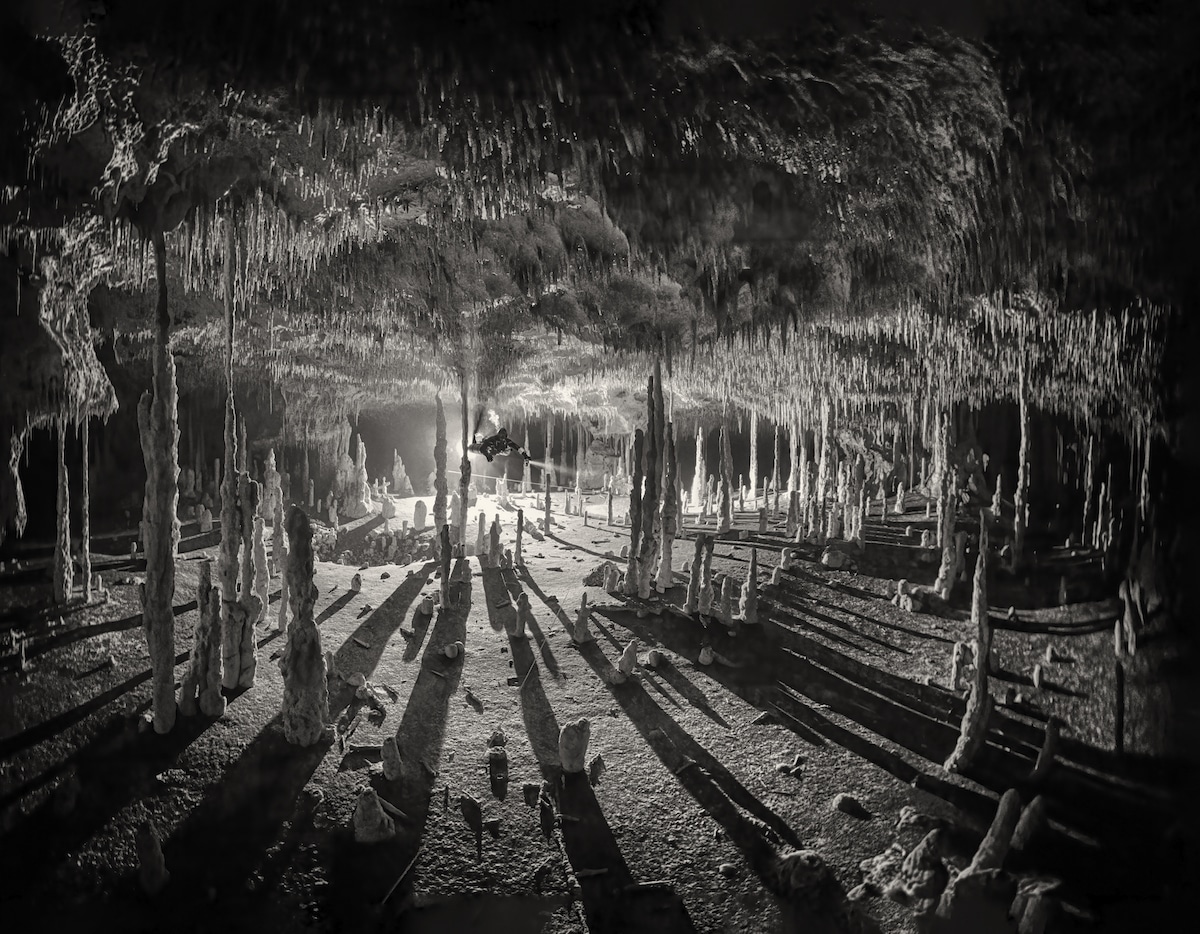
“Long Shadows” by Martin Broen. Winner, Black and White
Shot in Cenote Dos Pisos, Riviera Maya, Yucatan, Mexico
“Getting further away from the exit to surface and safety, through the labyrinth of pitch-black tunnels, you get to see places with incredible pristine decorations.
These tunnels got bigger when the cave were flooded and were decorated by the slow dripping of the calcite when the caves are dry. This happened over multiple cycles each lasting 100,000 years! And in this case the tunnel formed in a bedding plane with thousands of tiny stalactites in the ceiling contrasting the few tall stalagmite in the floor that creates a labyrinth in itself and project those beautiful long shadows.”
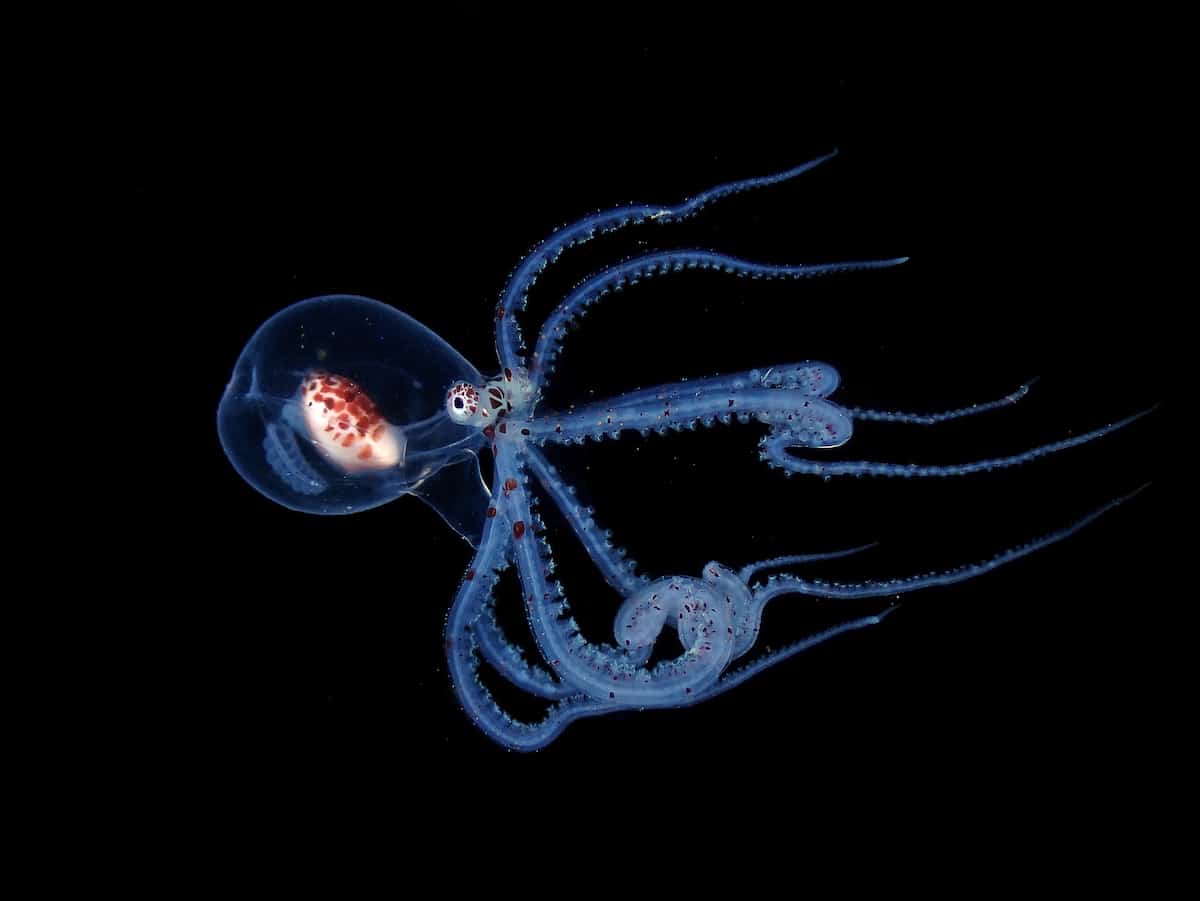
“Wunderpus” by Regie Casia. Runner Up, Compact Macro
Shot in Anilao, Philippines
“During a blackwater dive, shot at 25 meters deep over about 1000 meters of water, we waited for the vertical migration of deep water creatures.”
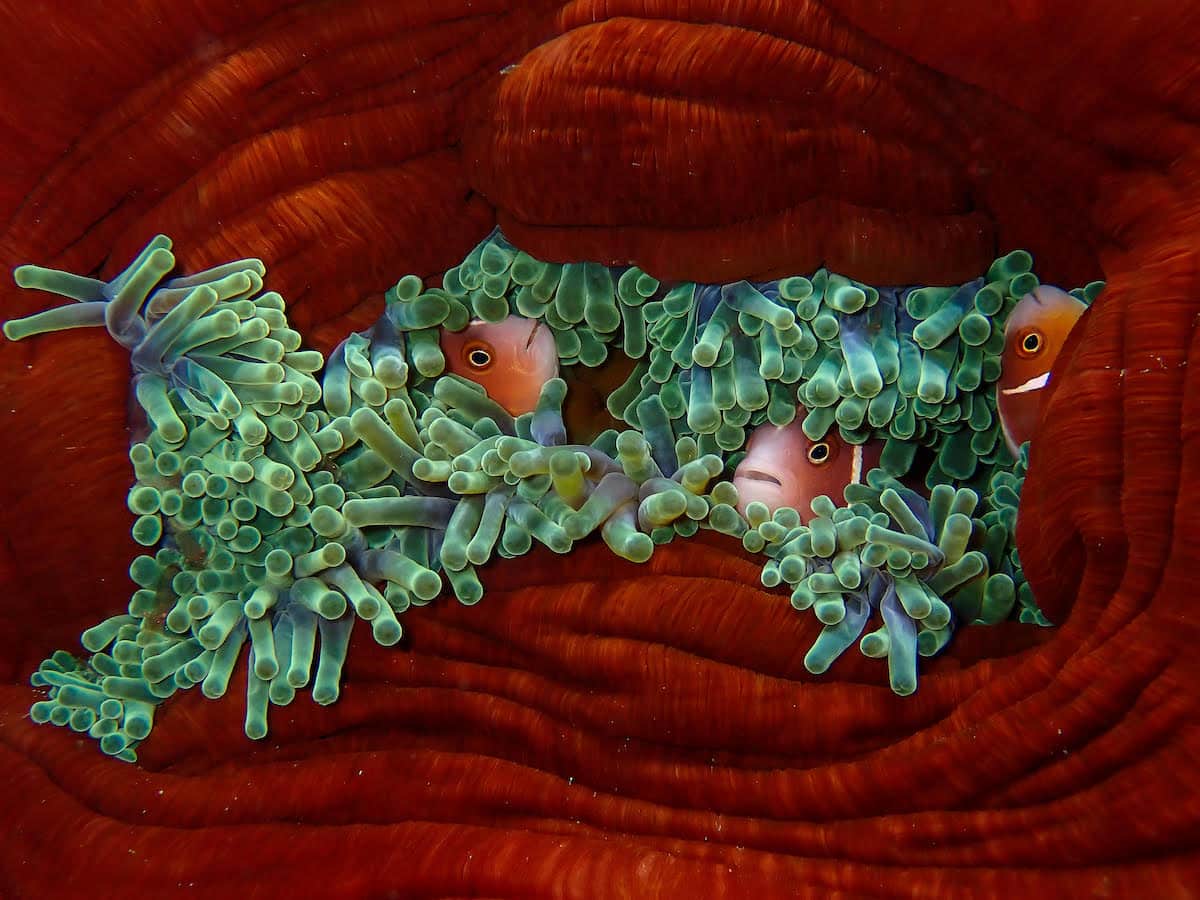
“Anemone Closing Time” by Sheryl Wright. Runner Up, Compact Behavior
Shot in Anilao, Philippines
“In July 2022 I joined a Minke Whale liveaboard trip to Cairns and in between encounters also had the opportunity to dive many beautiful coral reefs. I was enjoying my first dive of the trip with a new Olympus TG-6 camera and testing the settings when a beautiful red anemone positioned on the side of a coral bommie caught my eye. I was mesmerized watching the 3 Skunk Anemone fish or Clownfish swimming freely in and out of their hosts protective tentacles, when all of a sudden the anemone started closing. I managed to capture the confused little faces of the fish in that moment before the anemone started opening again and we all breathed a sigh of relief. I was very happy with the image straight out of the camera and did very little post-production. I started to remove the sand grains from the image in editing but decided these small imperfections created a level of authenticity.”
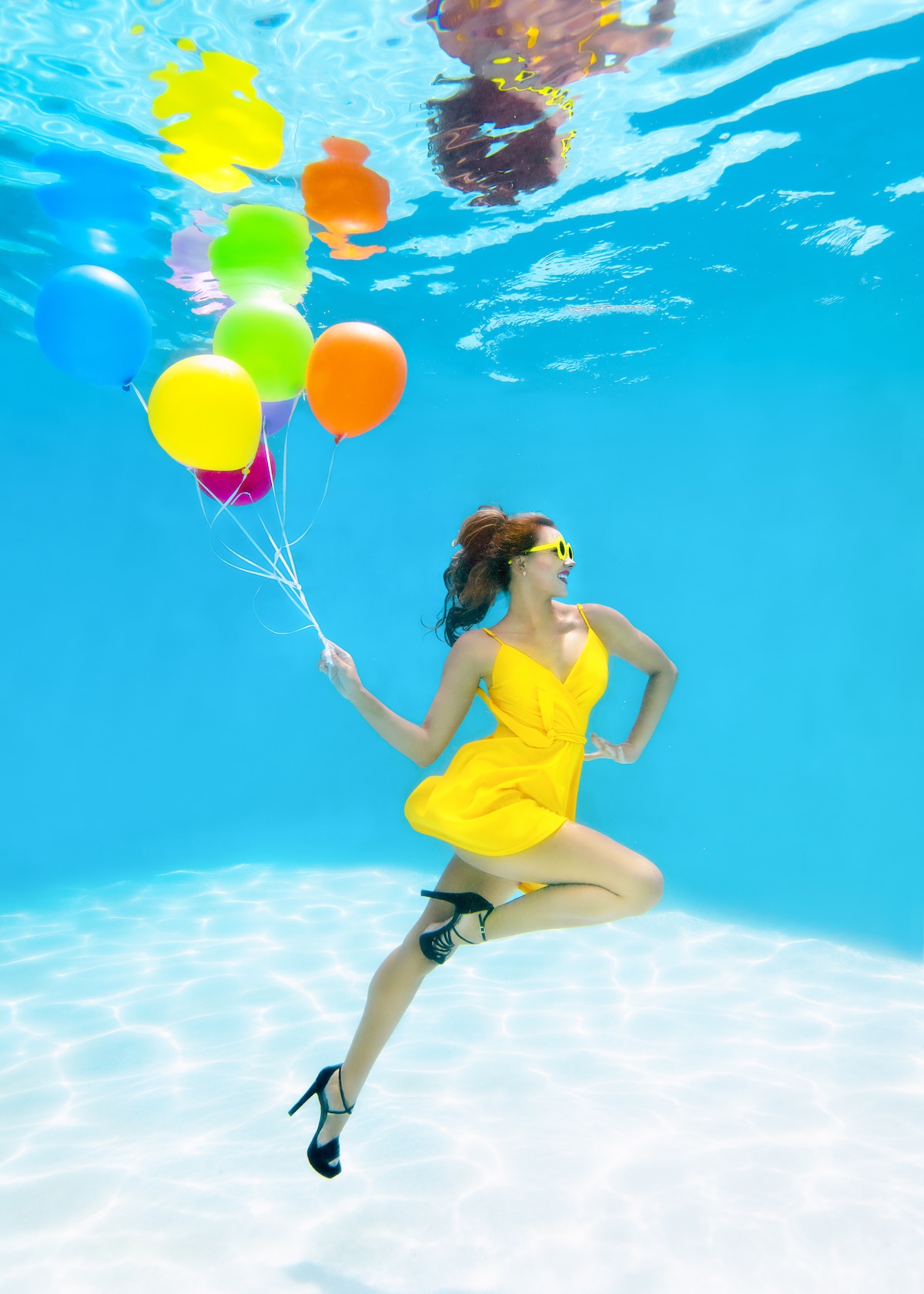
“A Happy Bunch” by Sarah Teveldal. Winner, Underwater Art
Shot in Private Residential Pool, Miami
“Underwater performer, free diver and four-time World Champion Synchronized Swimmer Kristina Makushenko and I worked together to get this colorful, fun-spirited image. Balloons can be difficult to work with underwater, but we are both underwater enthusiasts who appreciate a challenge! The trick to working with the balloons is achieving a nearly neutral buoyancy. To do this, you must fill them with the right water-to-air ratio which is mostly water and just a tiny breath of air.”
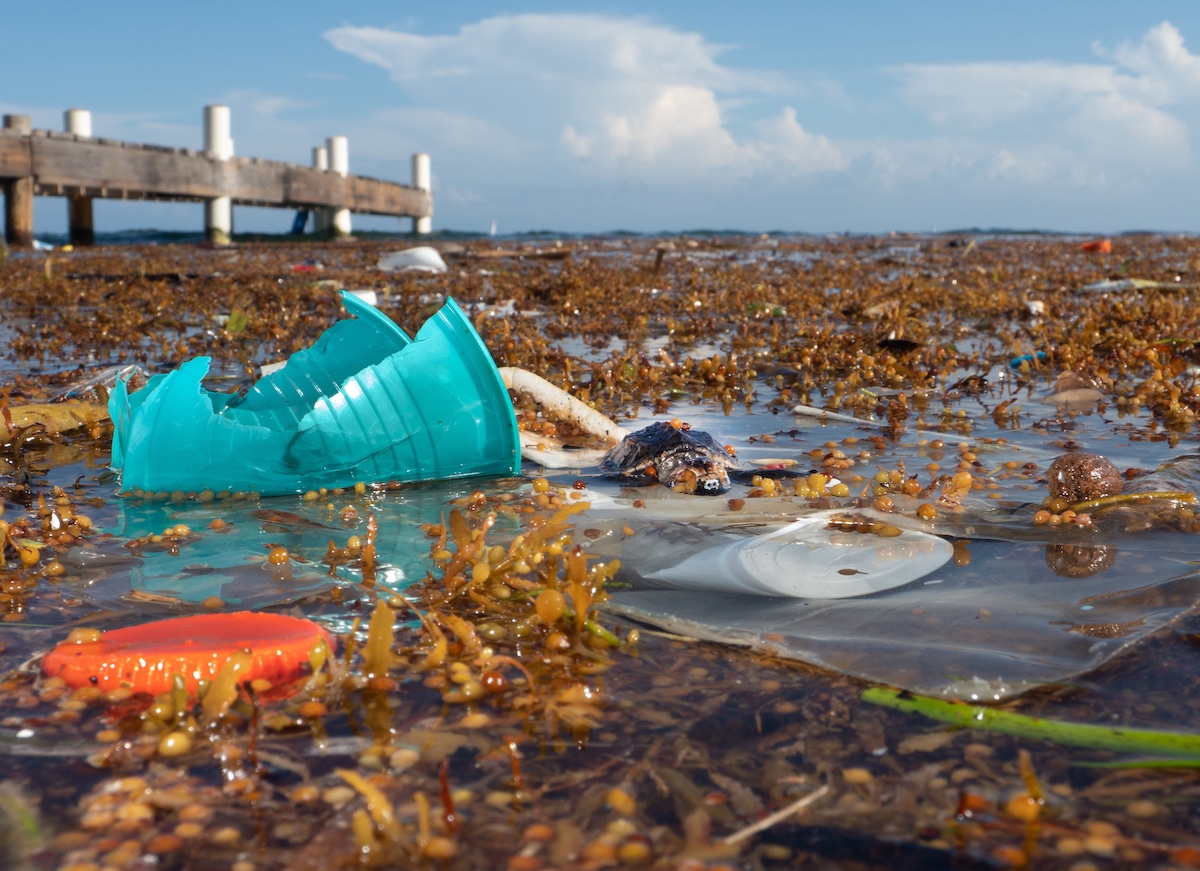
“Drowned in Plastic” by Caroline Power. Runner Up, Underwater Conservation
Shot in Honduras, Roatan
“During hatching season, juvenile turtles head out to sea and seek shelter on anything they can find. Sargassum mats provide ample shelter among the seaweed as well as food for the young turtles. It is their oasis in a hostile ocean. Many spend their first years of life sheltering there. I received a call that a plastic filled sargassum mat was washing ashore. There were hatchling sea turtles in it that were becoming trapped in the thick garbage as it hit the shoreline and were in need of rescue. A group of rescuers and I spent the better part of two hours wading through the plastic filled water in search of any live sea turtles. I took my camera with me, precariously dragging it through the thick plastic soup as I searched for live hatchlings. I snapped a few photos along the way not because it was a memory I wanted to be reminded of. I took the photos in hope that they might make people realize what we are doing to the oceans.”
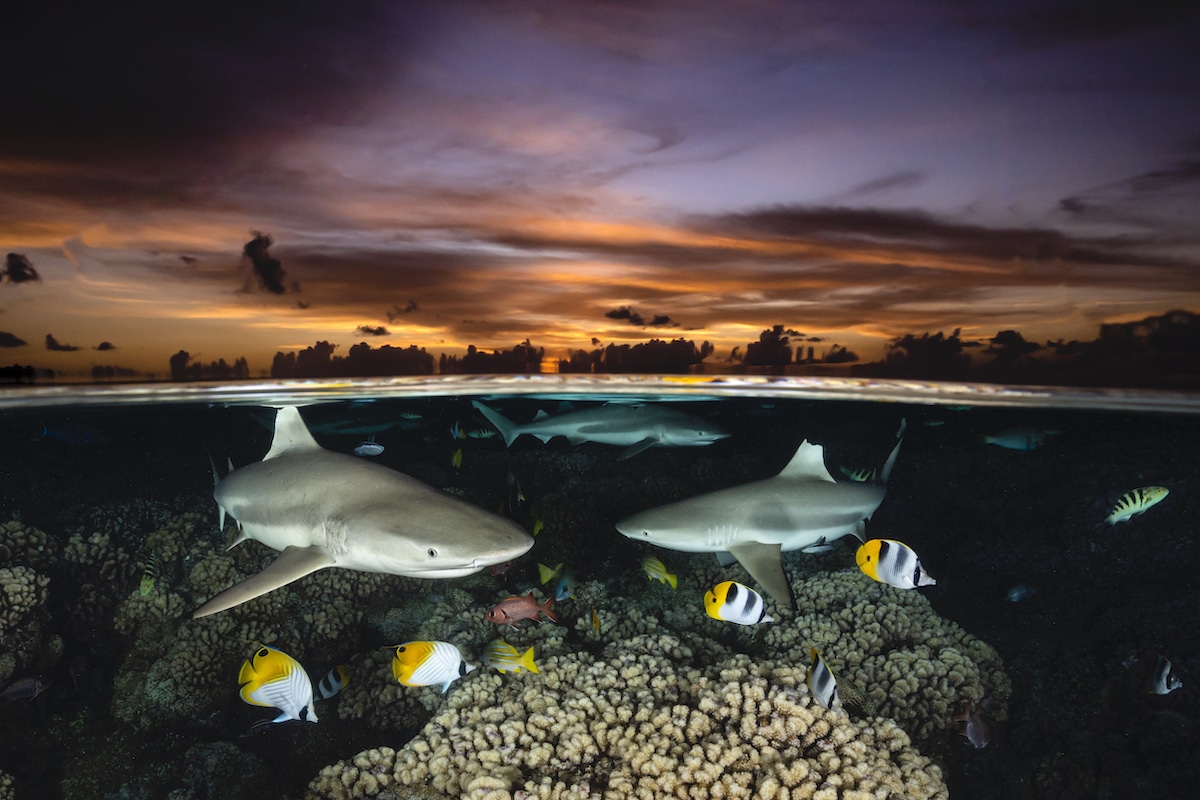
“Shark Trio” by Renee Capozzola. Winner, Wide Angle.
Shot in South Fakarava, French Polynesia
“Blacktrip reef sharks and butterflyfish gather around a healthy hard coral reef in South Fakarava, French Polynesia at sunset. This is a single, in-camera image.”
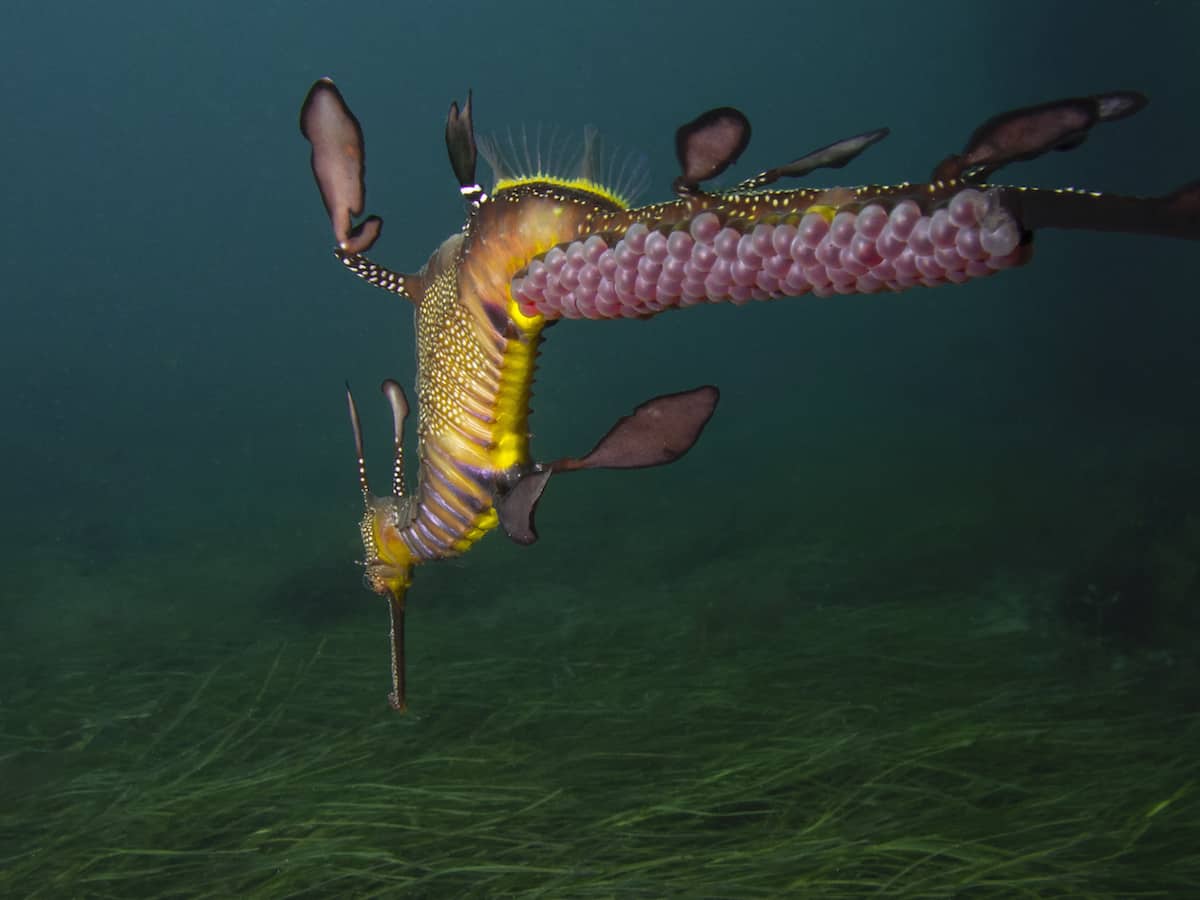
A Male Weedy Seadragon Carries Pink Eggs On Its Tail” by PT Hirschfield. Winner, Compact Behavior
Shot in Victoria, Australia
“Last year in the judges’ comments, it was advised to find new ways to photograph common subjects. While definitely ‘other-worldly’, male weedy sea dragons carrying bright pink eggs on its tail are not a particularly unusual subject on the south-east coast of Australia. These slow moving animals are typically very happy to pose side-on at close range in only around 4-6 meters depth. But I loved playing with the principles of photography in making this image. I observed the ‘Rule of Thirds’ and the principle of ‘edge consciousness’, but broke the ‘rules’ of shooting the subject from the front with sharp focus on the eye. Shooting this dragon from the back with its eye down and not as a focal point revealed an angle of this bright beastie that’s rarely seen. The egg closest to the top right hand side appears to have already hatched (which I did not realize until I saw the image at home on the computer), with almost ninety other eggs nearing their hatching time.”
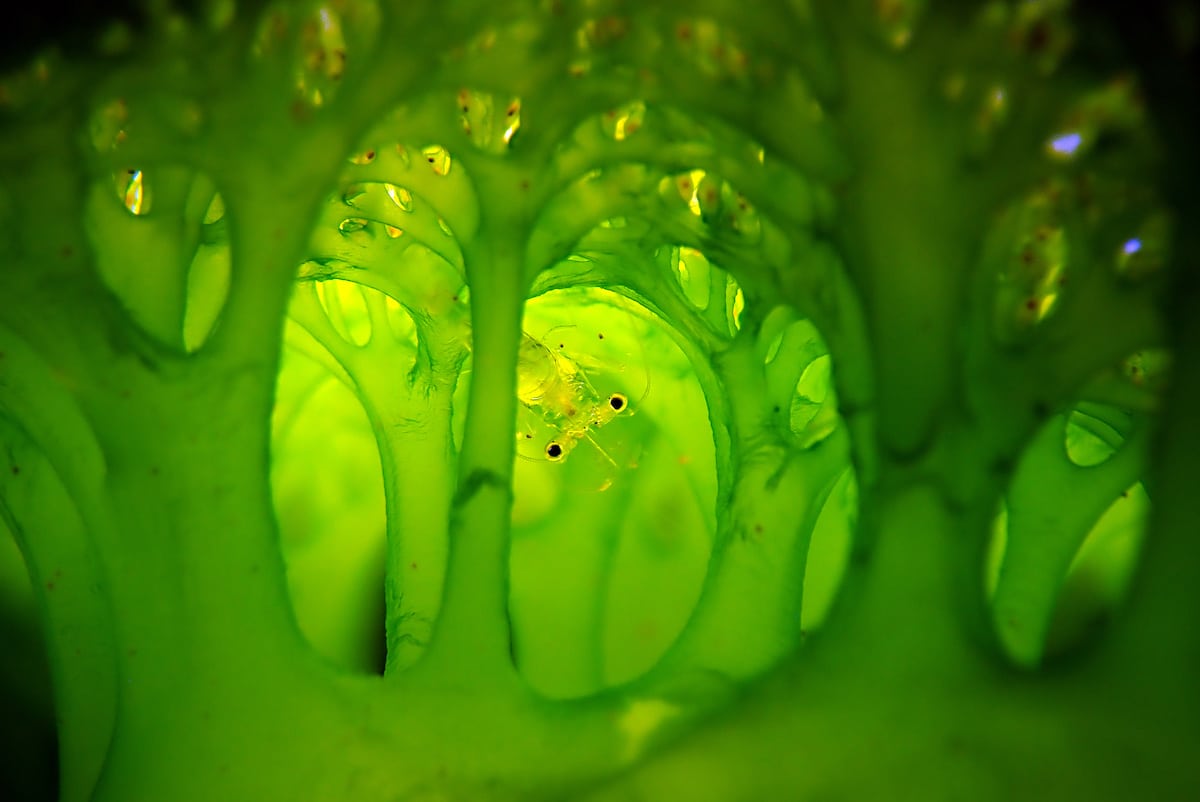
“E.T. The Extra-Terrestrial” by Eunhee Cho. Winner, Compact Macro
Shot in Dauin, Negros Oriental, Philippines
“I considered filming for a short time without strengthening the light because the sea squirt, which does not like the heat, narrows the entrance right away when I start filming. Also, shrimp are sensitive to sea squirts' movements, so I tried to film calmly without rushing. From the moment I found the shrimp in the sea squirt until just before the sea squirt entrance was closed, this cute little shrimp kept an eye on me without much movement. It was as if this shrimp understood my mind to take pictures while being pressed for time, and I thought of E.T., the big-eyed alien in the movie I saw as a child. It was a lucky day when a small sea creature was considerate of me and I was able to shoot.”
Photographers from 96 countries entered their work, which was judged by an expert panel of underwater photographers.
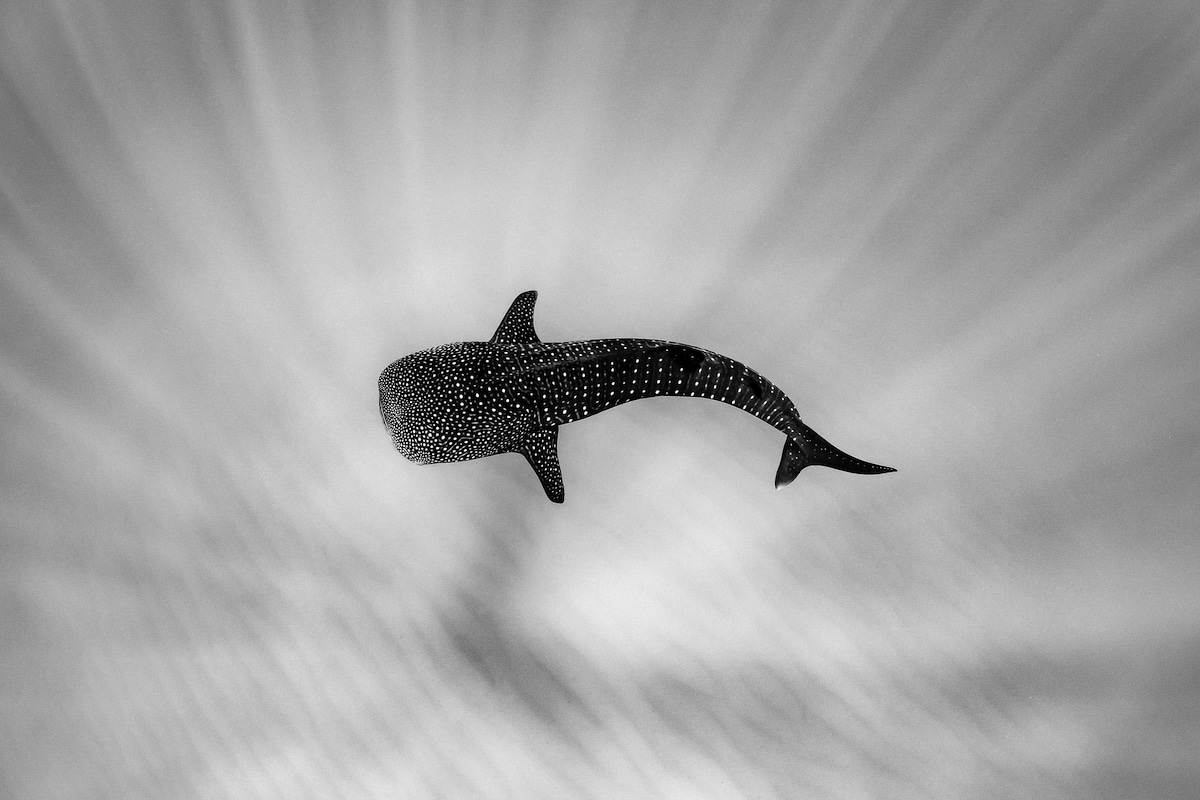
Cruising the Sand Patch” by Brooke Pyke. Runner Up, Black and White
Shot in Ningaloo Reef, Western Australia
“On the clearest day on the Ningaloo I have experienced so far, our spotter pilot called in a whale shark on a shallow section of reef. To see them so shallow is not an everyday occurrence, and with the visibility it may have been the best time to see one in such an area. The whale shark began to cruise slowly over a huge white sand patch at about 15m depth. Looking down on the huge shark from above as it swam below me , made it almost look miniature. Its perfect outline is dark against the white background, showing its shape with perfect contrast.”
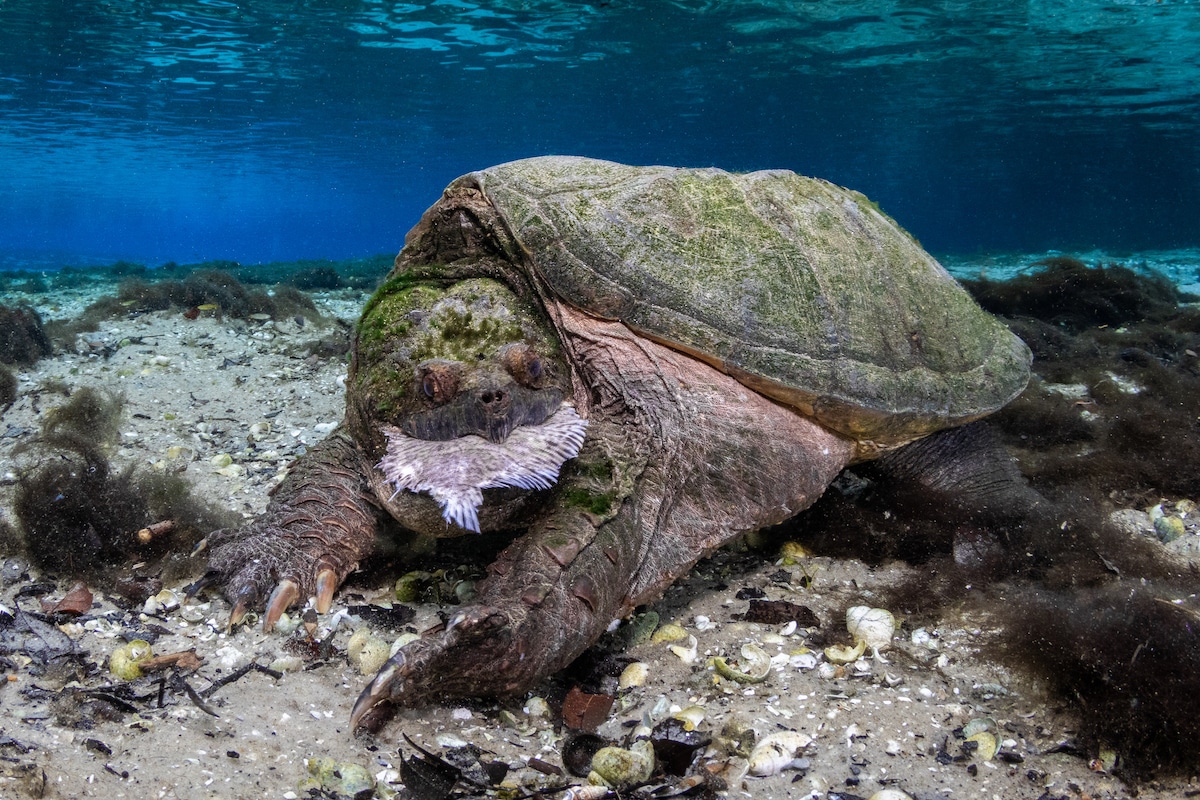
“Chew With Your Mouth Closed!” by Bryant Turffs. Runner Up, Marine Life Behavior.
Shot in Florida, USA
“I captured this image while exploring a freshwater spring and river. Although I set out looking for manatees, my attention was captured by this common snapping turtle. I spent several hours observing her at a respectful distance and moving in to make images now and again. This individual is apparently blind and did not seem to mind my presence. She went about her business alternately resting, breathing, and foraging. Eventually, she came across a dead flatfish, commonly known as a hog-choker. The fish’s name comes from the tendency for its spines to get caught in pigs throats when scavenged. The spines, however, were no match for this turtle. She positioned the fish in her mouth and began to scrape away the spines with her forelimbs, as depicted here. Once satisfied she swallowed the remaining fish whole. Common snapping turtles play an important role, scavenging carrion from aquatic ecosystems in the South Eastern United States. The species is, however, omnivorous, and will consume vegetation and live prey too.”
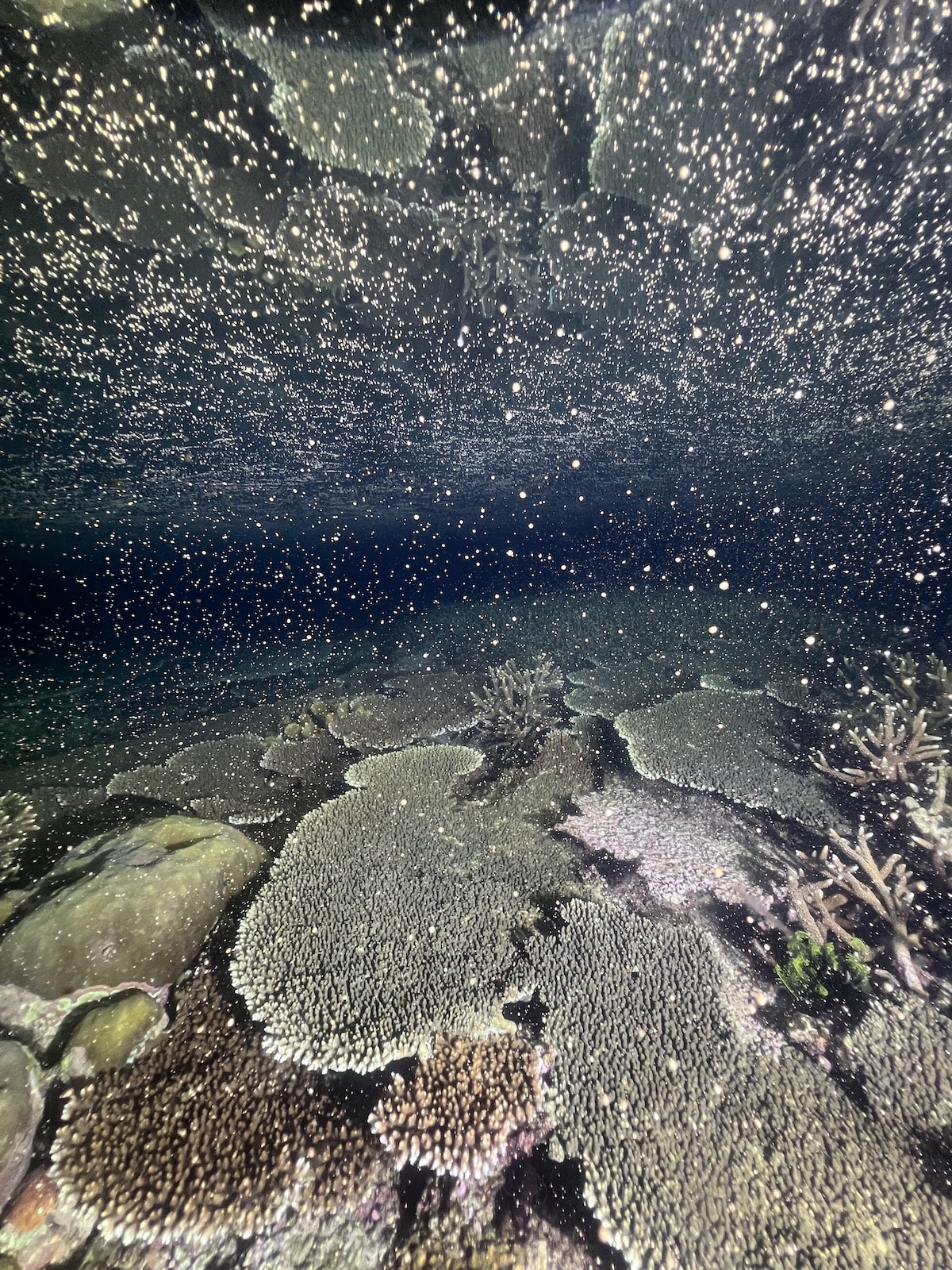
“Coral Spawn” by Chris Gug. Runner Up, Mobile Phone
Shot in Raja Ampat, Indonesia
“The dive manager/naturalist Sabine at Misool gave me an insider's tip the night before this photo was taken. While it's not well-documented or studied, she had witnessed a coral spawn event on this moon cycle in past years, and believed there was a chance that corals might spawn within the next day or three. So my wife & I sat out on the dock all night, skipping dinner, a presentation, and some sleep. But finally, a very fishy stanky smell filled the calm air. Looking down into the water below with the phone flashlight showed egg packets beginning to pop up to the surface. I slipped off the dock to document the event, but not knowing if we would have seconds, minutes, or hours, the phone that was already in my hand was the best camera for the job, which I feared might be over before I could even get in. But it did go on for quite a while – more than 30 minutes on two consecutive nights. The gametes formed a slick on the calm surface, and the smell was like opening unrefrigerated week-old fishy cheese, which seemed to cling to my body (and my wife's long, curly hair) for the next day. But what an incredible experience it was, watching the coral do it's thing, and the bounty that it provided the rest of the reef's inhabitants on that night from crabs filtering as much of a meal as possible, up to the black-tip sharks rapidly cruising through trying to take advantage of a smaller fish busy gorging themselves – I'll gladly get covered in that coral stank any time!”
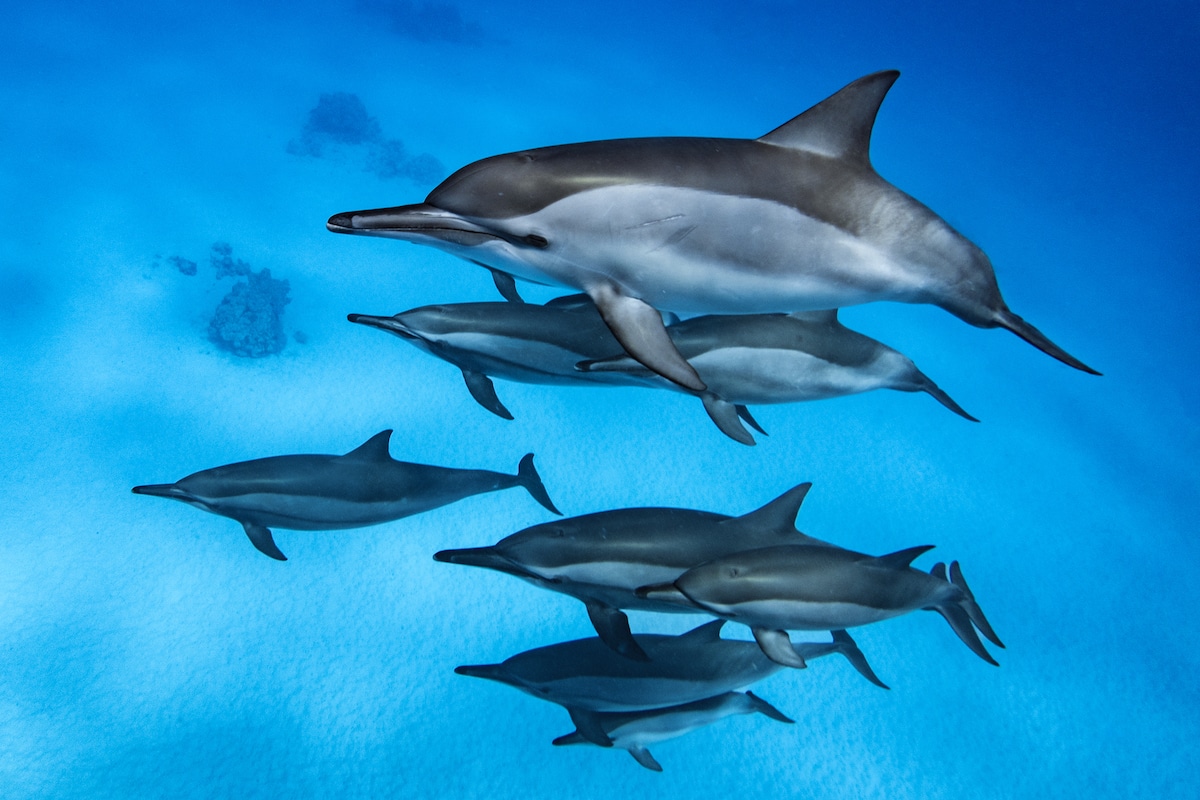
“Dolphin Formation” by Felix Beck. Runner Up, Compact Wide Angle
Shot in Sataya Reef, Egypt
“This curious group of dolphins was playing with us as we were snorkeling in Sataya Reef, Egypt. Dolphins are commonly found here but due to their fast movements it was quite difficult to take a good picture. With a fast shutter speed and a lot of patience, I finally managed to get this shot of the whole group passing by.”
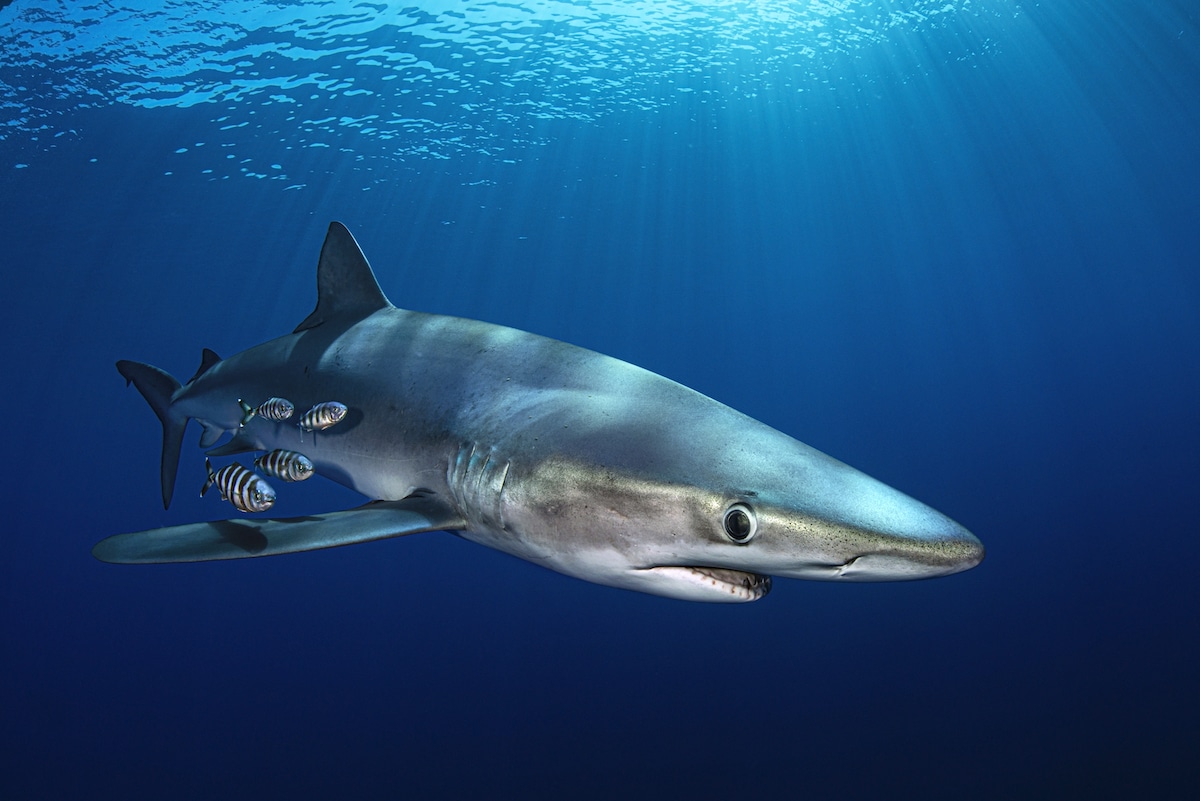
“Shark Portrait” by Gabriella Luongo. Runner Up, Portrait.
Shot in Azores, Portugal
“I have always dreamed of taking photos of sharks in the blue and finally got an opportunity this summer in the Azores. No fear, no stress of any kind – only peace and a sense of community with nature. These animals are so intelligent and curious. Once accepted by them in their environment, you can do nothing but admire their elegance. Diving among them is a privilege and a memory I will never forget.”
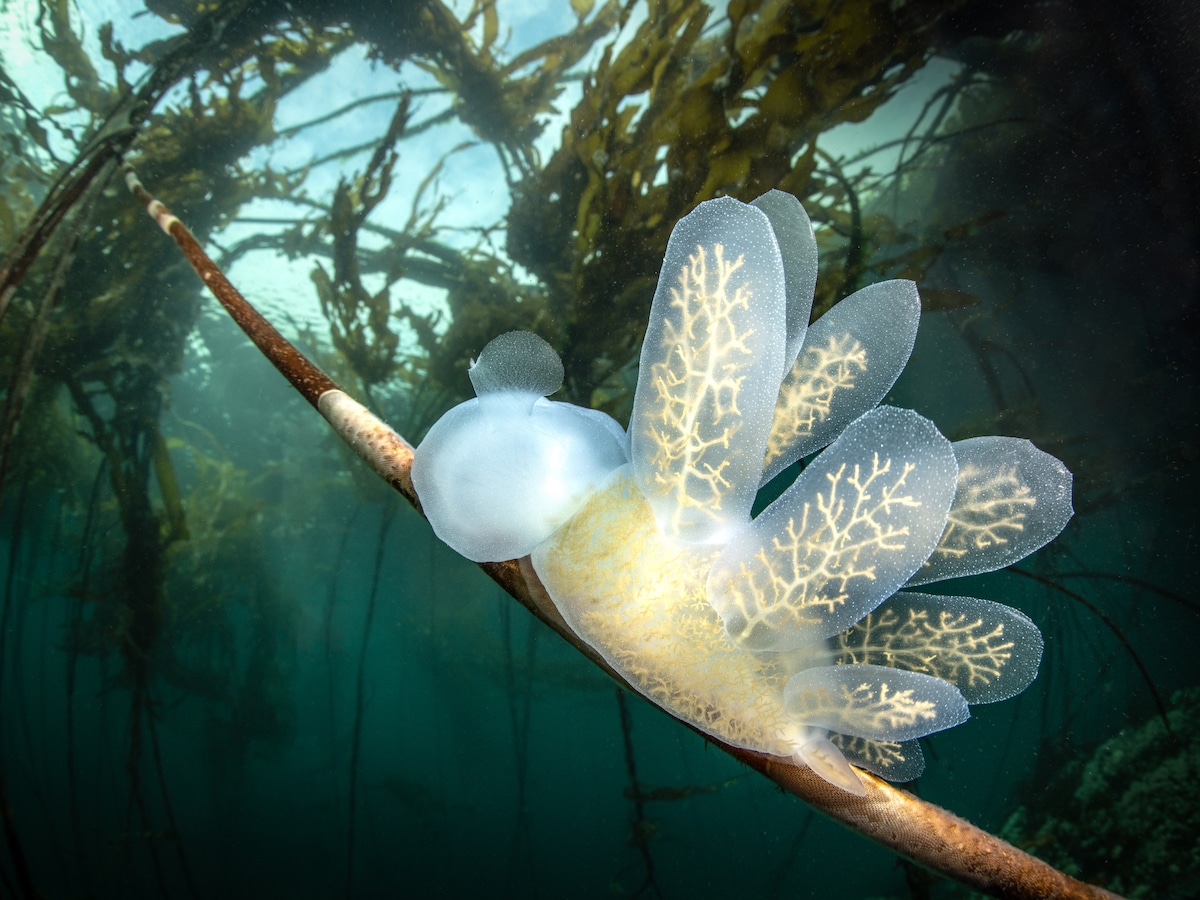
“The Climb” by Veronika Nagy. Runner Up, Nudibranch
Shot in British Columbia, Canada
“This scene combines so many things I love – a kelp forest, turquoise waters, and a hooded nudibranch. Hooded nudibranchs are very unique with an oral hood that looks like a venus-flytrap and paddle-shaped cerata beautifully displayed by this individual. I was drawn in by its contrast against the dark forest background and the way it appeared to be on a journey to the surface.”
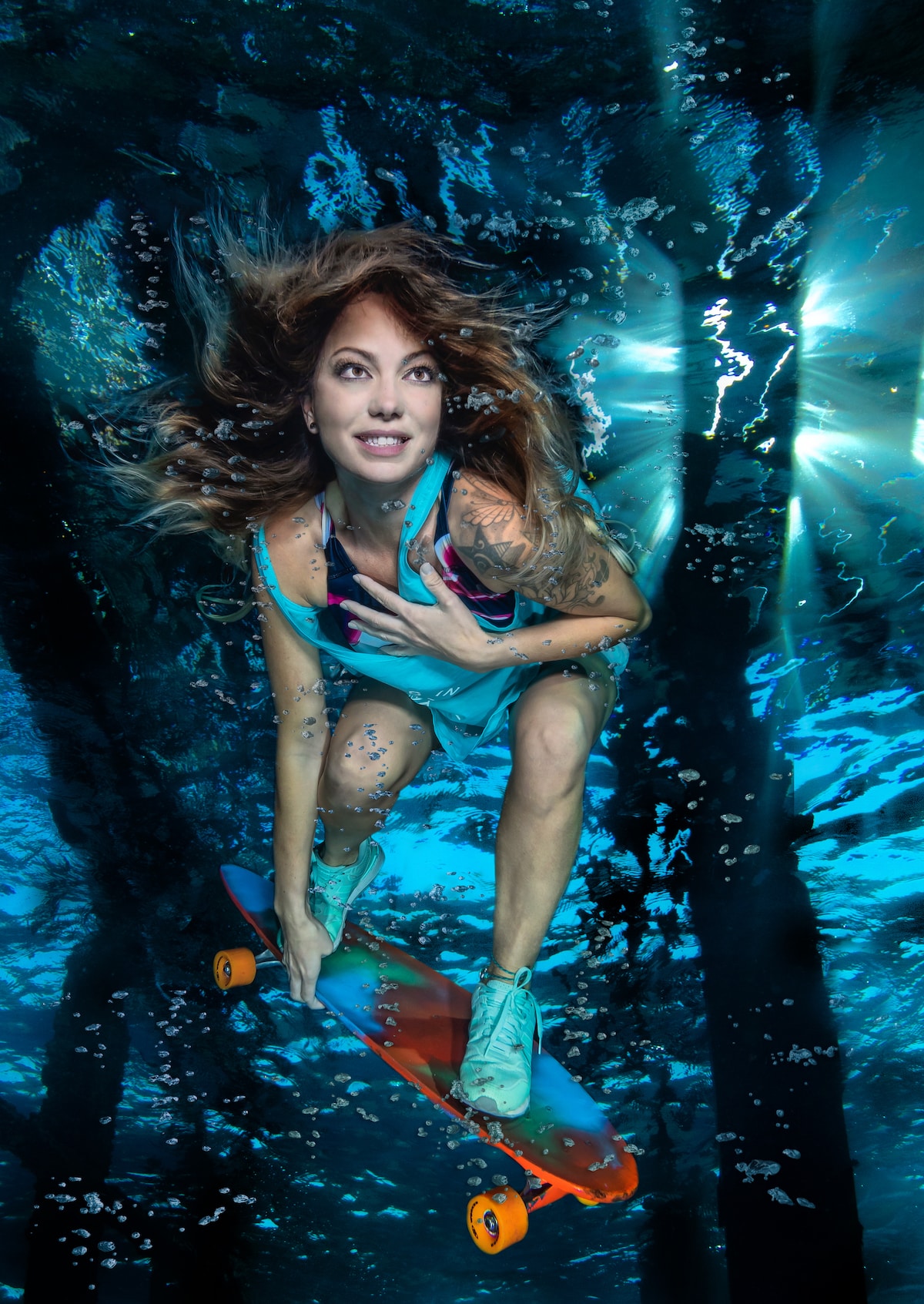
“Staker” by Julian Nedev. Runner Up, Underwater Art
Shot in Faenza, Italy
“The model, Jessica Avellaneda Aristi, is a real skateboarder and she suggested we do this underwater. The sneakers used to be bolted to the skateboard.
I did this photo manipulation to match the gorgeous model with a more dramatic background. The model is also isolated from the black background of the original photo and shines with radiance.”
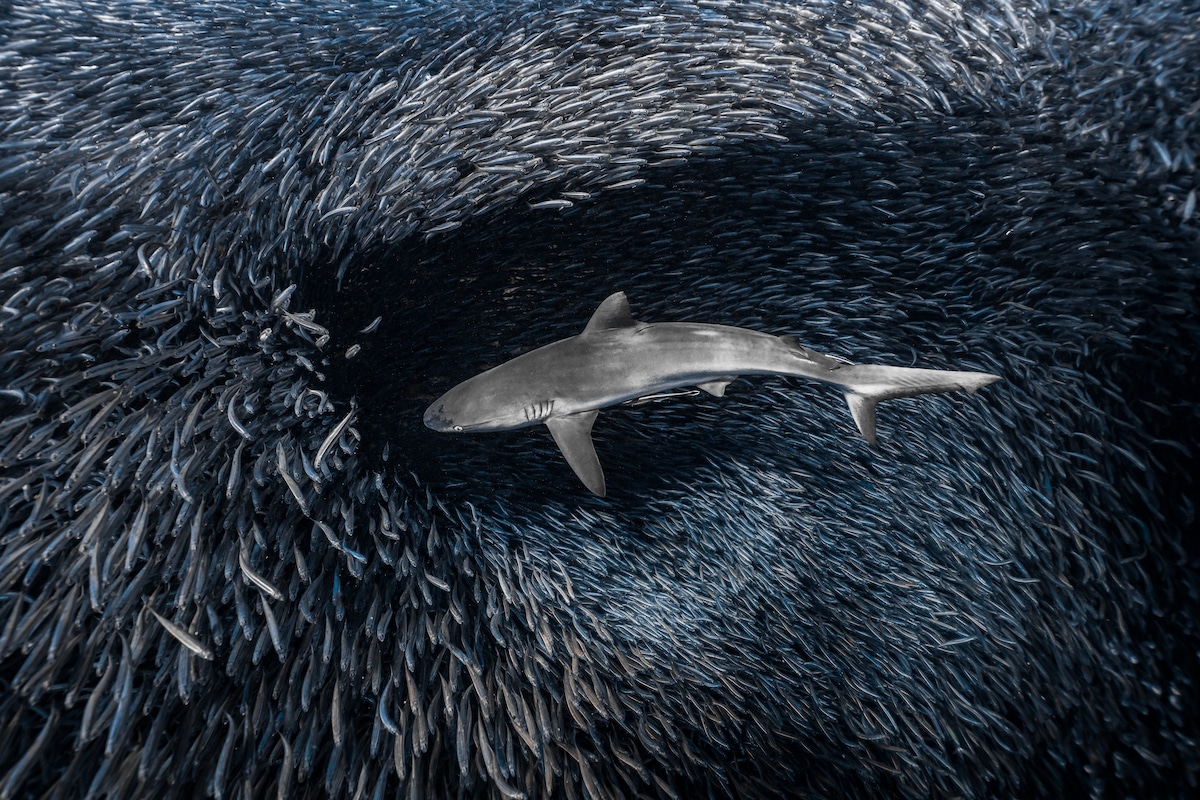
“The Hunt” by Daniel Nicholson. Runner Up, Wide Angle.
Shot in Ningaloo Reef, Australia
“A grey reef shark parts the tide of bait fish. In a very rare occurrence, a large shiver of sharks had herded this school of bait fish into the shallow passageways of the Ningaloo Reef. With the fish trapped here, nearly a hundred sharks spent hours in a feeding frenzy. After swimming around this bait ball for nearly an hour, I finally plucked up the courage to dive into the middle of it. Being in its midst was electrifying, with sharks darting in every direction whilst hunting. I had only fractions of a second to capture this shot, as the shark sped past me less than a meter away, intent on its next mouthful of fish.”
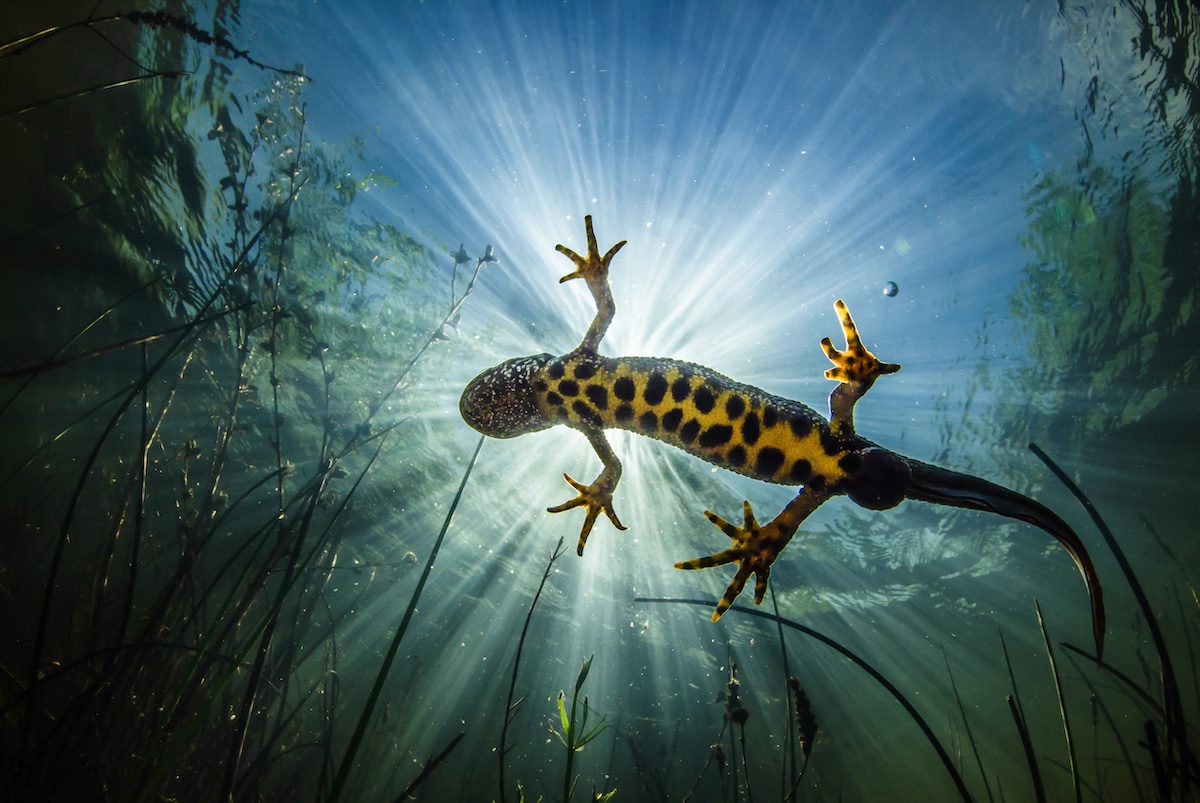
“Jaws” by Yannick Gouguenheim. Runner Up, Coldwater
Shot in South East of France
“I made this picture in the only pond of the south-east of France where the species is present.
I am passionate about urodeles and this species is in my opinion the most beautiful marbled newt.
The shots are quite difficult because this animal is fast and the water is very cold during the reproduction period. It took me many hours of waiting underwater to succeed in capturing this picture.
This species has a very wide range and is still locally common, but it has experienced a very strong regression and has become more or less rare in most of its range. The important rarefaction of the great crested newt is due to multiple factors: intensive agriculture and agricultural consolidation, urbanization of plains, road development, water pollution, lowering of the water table and first of all the filling of ponds or their artificialization as fishing areas. It disappears quite quickly from ponds where fish have been introduced.”
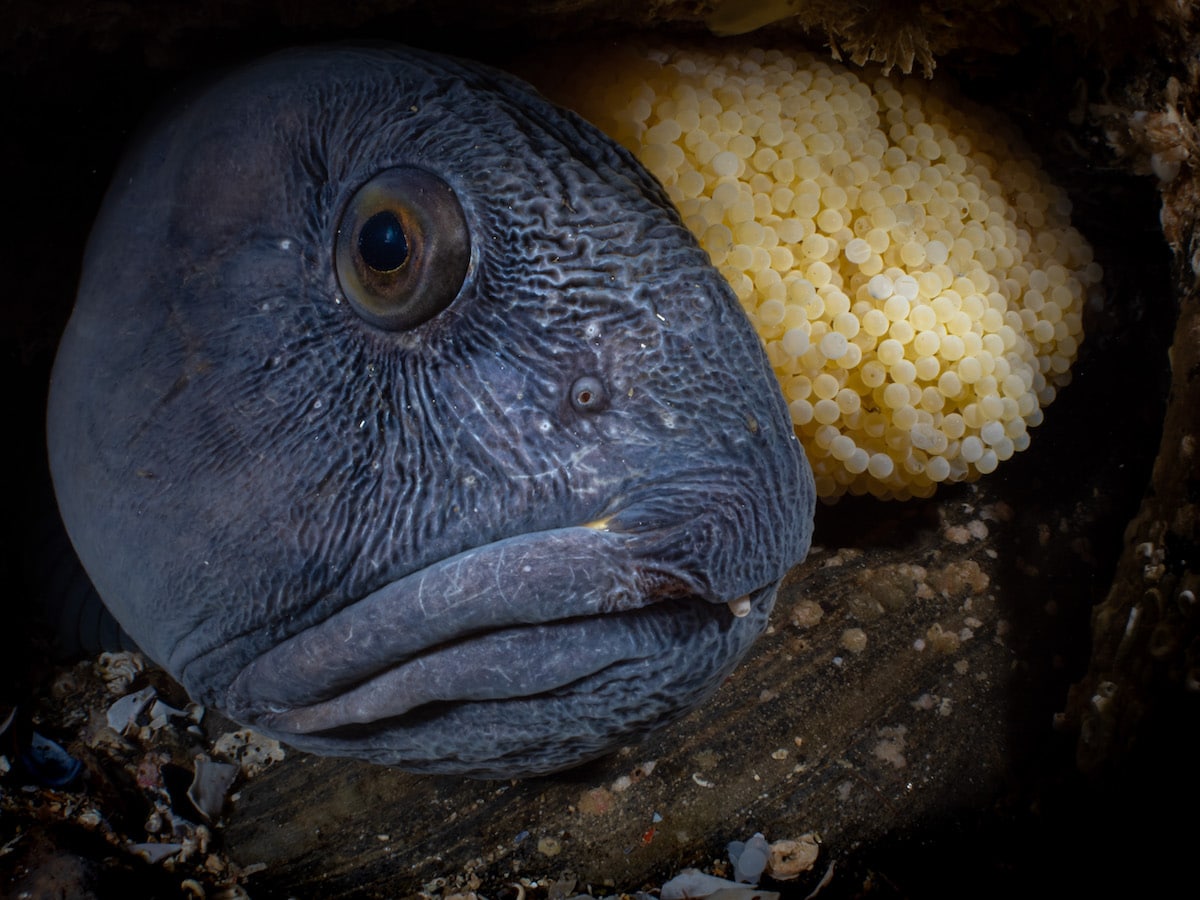
“Nest” by Galice Hoarau. Winner, Marine Life Behavior.
Shot in Saltstraumen, Norway
“A Wolfish (Anarhichas lupus) pair at the end of the arctic summer. The female lay a ball of eggs in a small cave in the autumn before leaving the nest, leaving the male to watch over them. The male will take care of them until the end of spring when they hatch. Wolfish are very important species in Norwegian fjords, keeping the sea urchins from overgrazing the kelp forest. Unfortunately, although they are overexploited, they don’t have any protection in Norway.”
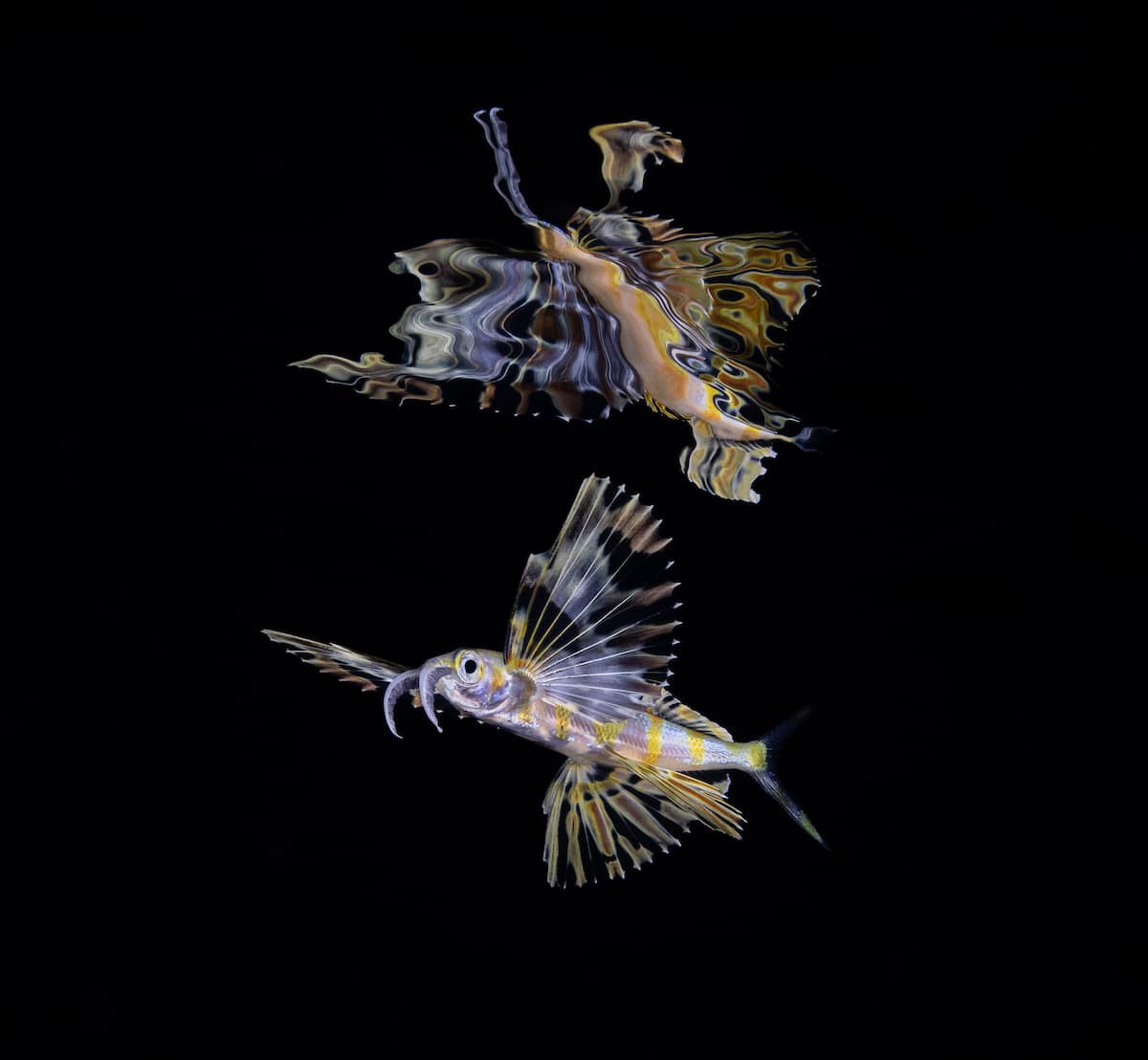
“Cleared for Takeoff” by Josh Raia. Runner Up, Blackwater.
Shot in Florida, USA
“This photo was taken in June of 2022, on a flat calm night in the Gulfstream off of Palm Beach, Florida. I always try and reserve half an hour at the end of each blackwater dive to spend time at the surface, looking for critters in floating mats of sargassum (a fascinating mini ecosystem!). With the conditions being so serene, it was an excellent opportunity to try and snap reflection photos just below the surface. Sargassum flyingfish are constantly swimming, and an accidental startle will see them disapear into the night sky above. This particular subject was using my lights to hunt among the sargassum strands, and turned to face me for one photo with its reflection above. It then swam straight at my mask and took off directly over my head! We lovingly refer to them as “Fu Manchu flyingfish”, due to the mustache-like protrusions over their mouths.”
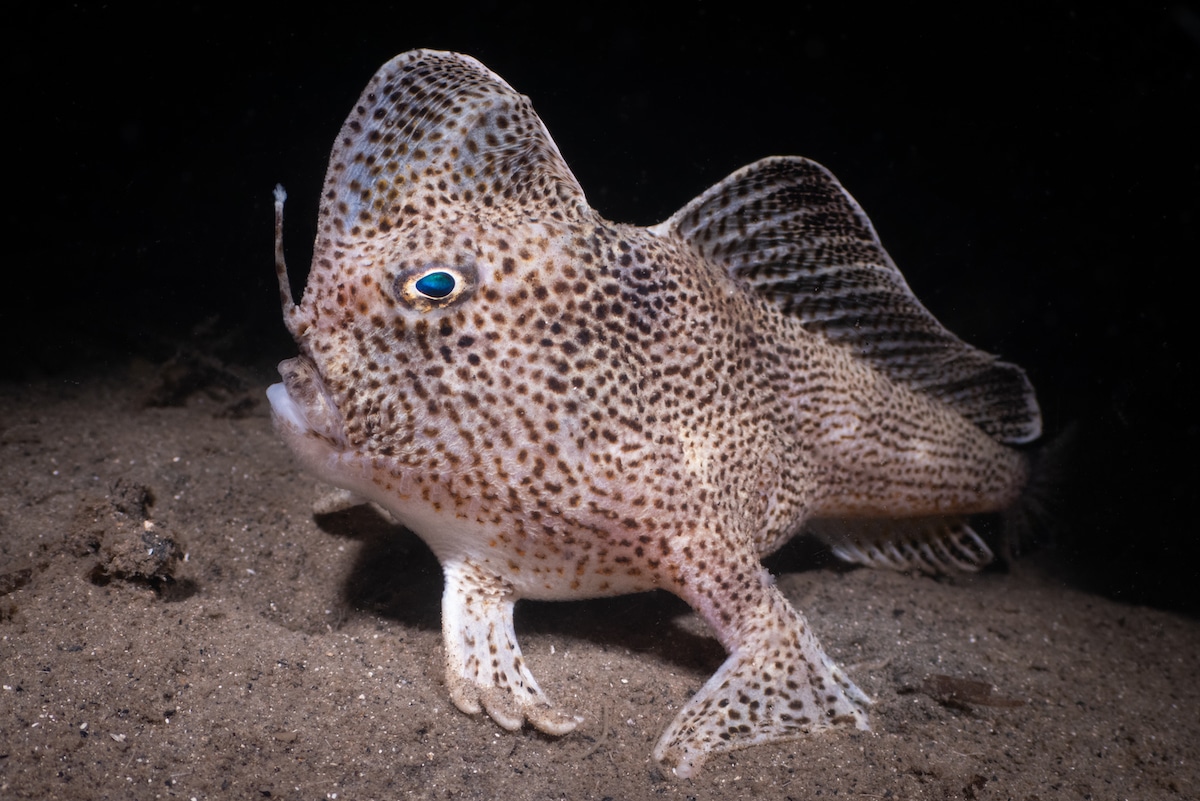
“The Rare Spotted Hand-Fish from Tasmania” by Nicolas Remy. Winner, Coldwater
Shot in Hobart, Tasmania, Australia
“The spotted handfish is a critically-endangered type of anglerfish which is found only in parts of Tasmania. It owes its name to its pectoral fins which resemble hands, and the fact that it “walks” on the seafloor.
It is believed that there are less than 3000 of them remaining in the wild. They were once common in Tasmania's waters, but are nowadays found only in a few rivers, only in Tasmania. Their decline is due to pollution of their environment, but also the invasive Northern Pacific Seastar, which feeds on their eggs.
During last Tasmanian winter, I spent 9 hours diving a patch of the Derwent River (Hobart, Tasmania) where I knew a few spotted handfish lived. The water was dark and silty with about 2 meters visibility, and I used two strobes with snoots to illuminate only the handfish and less of the floating particles.”
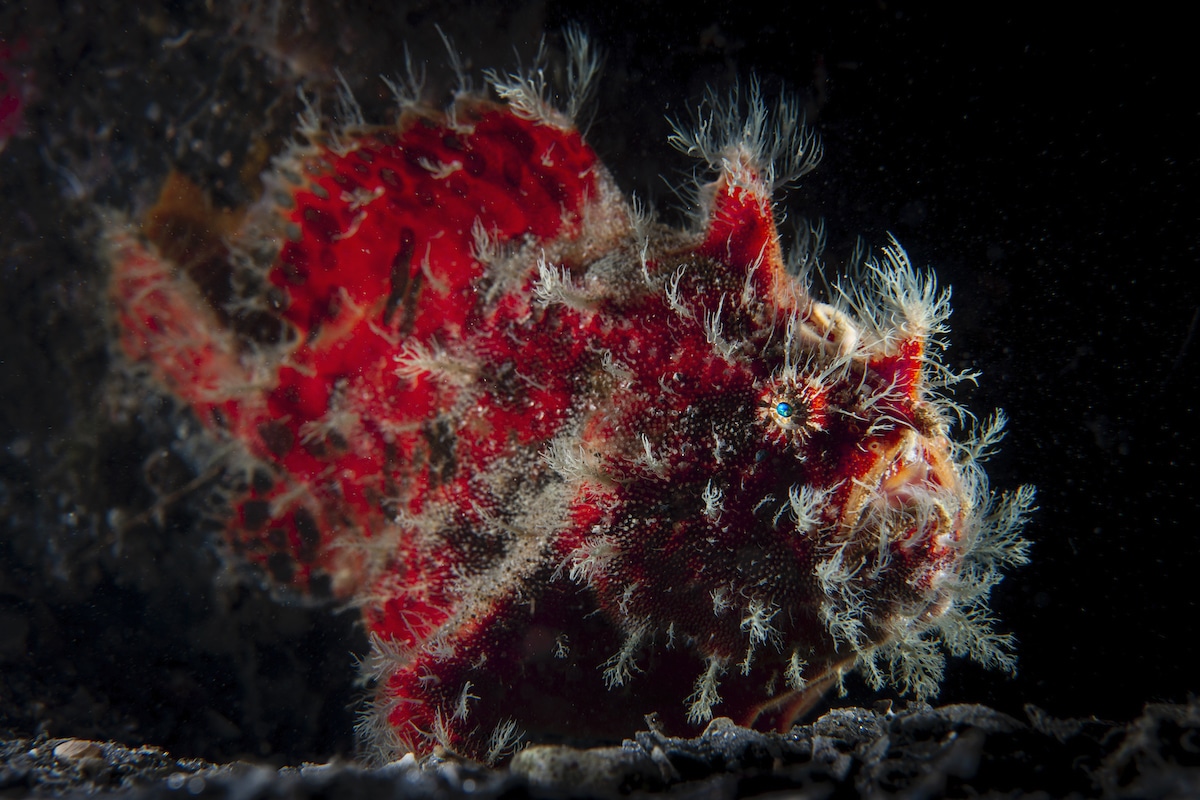
“The Lady in Red” by Matthew Sullivan. Runner Up, Macro.
Shot in Florida, USA
“I've been fortunate to see a lot of Striated Frogfish from various places around the world but I'd never seen a red flavored one. I found this massive and spectacular female resting against a dock piling in the dark. Red is the fastest color to fade underwater so until lit by strobe light we had no idea what she really looked like. My jaw hit the ground when I looked at my LCD and saw her true color. She is my favorite frogfish I've seen.”











































































